
Wild in Detroit and Michigan
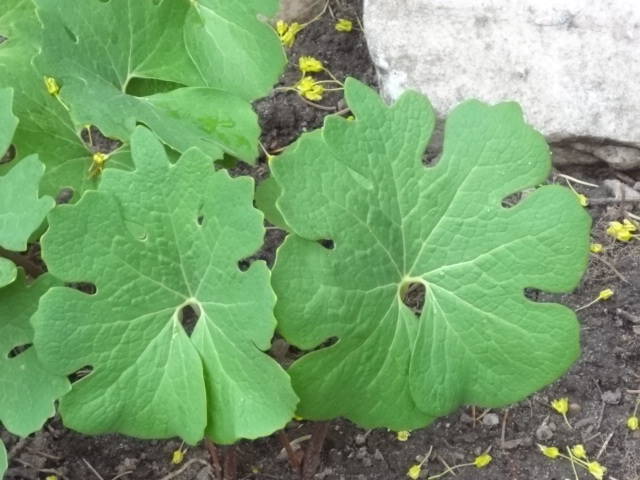 Spring 2014 - Yes, after the winter from Hell, it is finally warm enough to call this a spring. Though I no longer get up north at this time of year, I have been visiting the woods on Camille's farm northeast of Ann Arbor, and I participated in a wildflower tour on Belle Isle, too. Unfortunately - after years of faithful service - my Pentax ZX-30 (film) camera recently died. I am hoping this is a temporary condition, but meanwhile, I have missed a couple of photo-ops on wildflowers that are not in my collection below. I did snap them using my little Sony digital, but the results are nowhere as good. I completely missed out on photographing spring beauty which was blooming in abundance at Camille's, and Jack-in-the-pulpit on Belle Isle. I did get a nice picture of bloodroot for the first time. Here is a picture of it's cool leaves which I took with my digital camera. This is from my own back yard where I transplanted some of the spring bloomers from Camille's farm and from the Belle Isle woods, too.
Spring 2014 - Yes, after the winter from Hell, it is finally warm enough to call this a spring. Though I no longer get up north at this time of year, I have been visiting the woods on Camille's farm northeast of Ann Arbor, and I participated in a wildflower tour on Belle Isle, too. Unfortunately - after years of faithful service - my Pentax ZX-30 (film) camera recently died. I am hoping this is a temporary condition, but meanwhile, I have missed a couple of photo-ops on wildflowers that are not in my collection below. I did snap them using my little Sony digital, but the results are nowhere as good. I completely missed out on photographing spring beauty which was blooming in abundance at Camille's, and Jack-in-the-pulpit on Belle Isle. I did get a nice picture of bloodroot for the first time. Here is a picture of it's cool leaves which I took with my digital camera. This is from my own back yard where I transplanted some of the spring bloomers from Camille's farm and from the Belle Isle woods, too.
Early Fall 2013: Wildflower trends I have observed of late in the Detroit area. It seemed like birdsfoot trefoil was on the increase in the past couple years, but I have seen very little this summer. Instead, I am seeing a resurgence of butter and eggs. It seems to be everywhere all of a sudden. There was actually some of it growing on the median of my own street. I promptly transplanted a couple clumps to my backyard. It joins white wood aster and daisy fleabane which are also new transplants. I will have to put some markers so I don't pull any of it out as weeds next season.
August of 2013 saw another trip to the Lake Bellaire Cottage owned by distant relatives. This time my friend, Cami, accompanied me. We hit all the ususal spots: Seven Bridges, Grass River Natural Area, and Skegemog Swamp (one-mile path). This time we also walked in from the Schneider Road trail head to Lake Skegemog. Nice! We saw a lot of fungi along that path. I brought back a few sprigs of wintergreen and planted them in my back yard. I hope that they survive.
Here it is the 30th of April, 2013 and I haven't written in a long time. Spring is finally here - temperature-wise, and there are two things blooming in my back yard. The myrtle, of course, and the pieris. It's the second year in a row for my one pieris bush, and it looks so nice with its tiny white flowers cascading down. Lots of myrtle flowers perking up that wonderful ground cover. It's all over the back yard now, courtesy of my annual spring trips to the woods of Belle Isle.
 The week of August 13th: Four days up north at Natural Areas and riding down bike trails will translate to a bunch of new pictures of wildflowers below. I identified several wildflowers for the first time, and Kathy helped a lot. We saw even more that we couldn't identify - yet. When I get the my film developed, I will have a session with the wildflower books. Notably, we went to Skegemog Swamp and Grass River Natural Area, with its brand new nature center. The bike trails were a good source of flowers, too. The highlight of the trip from a bird standpoint was when we were riding the trail between Petosky and Charlevoix, and a huge barred owl swooped within a couple feet of us and then perched and sat in the tree above us. I managed to get a few pictures with my telephoto lens.
The week of August 13th: Four days up north at Natural Areas and riding down bike trails will translate to a bunch of new pictures of wildflowers below. I identified several wildflowers for the first time, and Kathy helped a lot. We saw even more that we couldn't identify - yet. When I get the my film developed, I will have a session with the wildflower books. Notably, we went to Skegemog Swamp and Grass River Natural Area, with its brand new nature center. The bike trails were a good source of flowers, too. The highlight of the trip from a bird standpoint was when we were riding the trail between Petosky and Charlevoix, and a huge barred owl swooped within a couple feet of us and then perched and sat in the tree above us. I managed to get a few pictures with my telephoto lens.
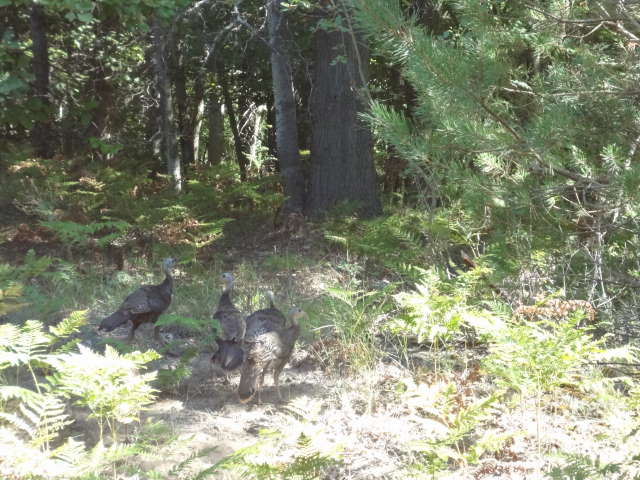 August 5th through 7th: Riding on the Pere Marquette Rail Trail - about fifty miles each way - provided a wealth of wildflower viewing. It was Kathy who spotted the cardinal flower - brilliant red, as always. When stopped to look at it, we noticed two other flower types. I was able to identify both, and both were new to me: Pine hyacinth, and Showy tick trefoil. Why didn't I bring my SLR camera??? Of course, Kathy was super at spotting and identifying birds - she is amazing in that way. From a boardwalk/bridge near Clare, we saw killdeers and a whole bunch of green herons. We heard lots of catbirds. But the best was when we pulled off the trail to look at a little lake. The driveway to the lake had a "No Tresspassing" sign, but I convinced Kathy that there were no buildings around and it wouldn't hurt to ride to the edge of the lake. Before we even reached the water, Kathy went nuts. With her bare eyes she picked out a bald eagle in a dead tree way on the other side of the lake! Through her binoculars I could see it perfectly. That was so awesome. Other animals we saw right on the trail, included deer, chipmunks, a green and yellow snake, rabbits, frogs, a family of wild turkeys (in the picture), seventeen million grasshoppers, and even a dead mouse. Bring on the next trail!
August 5th through 7th: Riding on the Pere Marquette Rail Trail - about fifty miles each way - provided a wealth of wildflower viewing. It was Kathy who spotted the cardinal flower - brilliant red, as always. When stopped to look at it, we noticed two other flower types. I was able to identify both, and both were new to me: Pine hyacinth, and Showy tick trefoil. Why didn't I bring my SLR camera??? Of course, Kathy was super at spotting and identifying birds - she is amazing in that way. From a boardwalk/bridge near Clare, we saw killdeers and a whole bunch of green herons. We heard lots of catbirds. But the best was when we pulled off the trail to look at a little lake. The driveway to the lake had a "No Tresspassing" sign, but I convinced Kathy that there were no buildings around and it wouldn't hurt to ride to the edge of the lake. Before we even reached the water, Kathy went nuts. With her bare eyes she picked out a bald eagle in a dead tree way on the other side of the lake! Through her binoculars I could see it perfectly. That was so awesome. Other animals we saw right on the trail, included deer, chipmunks, a green and yellow snake, rabbits, frogs, a family of wild turkeys (in the picture), seventeen million grasshoppers, and even a dead mouse. Bring on the next trail!
July 30th A day at Seven Ponds followed by a long day of bicycling on trails yielded a huge list of fildflowers observed, not to mention birds and butterflies. I intended to list the flowers that I saw, but I will limit it to the more interesting ones. There were several yet unidentified species, two in white and one in purple. (I later figured out that the purple was spotted Joe Pye Weed.) The blazing star was out in abundance, and there were tons of woodland sunflowers. A new one to me was rattlesnake master I did photograph it on a return trip a few days later. On the rail trail I saw the deadly poisonous water hemlock growing within easy reach from a bridge railing. I hope no one decides to touch it.
June 11th I'm a happy boy again because today I noticed a little stalk of Solomon's Seal growing in my back yard. Here I thought that I had transplanted it somewhere else, and so assumed that it did not survive from last year. It is so cool to have a wildflower growing in my yard.
May 17th: Now what's blooming? In front, there are irises (which didn't bother to bloom at all last year.) In the house is a little spathiphyllum with its single white flower towering at least one foot above the rest of the plant. Out back are pyracanthas and the weigelas. Much of what I mentioned below is still blooming, too.
May Day, 2012 - My back yard is looking so verdant after yesterday's rains. The lush carpet of dark green myrtle is filling in everywhere, and its existence is completely thanks to my annual spring trips to the woods of Belle Isle for the last six or so years. Right now there are spikes of ajuga growing through the myrtle with nice purple flowers. I think I planted that ajuga about twenty years ago. There are also bunches of white and blue forget-me-nots blooming that are problably about just as old. The two azaleas bushes are also in bloom. Though it doesn't have many flowers, the deciduous azalea is simply gorgeous. Its flowers are a striking shade of white with delicate pink highlights. No surprise, this is my favorite time of year to enjoy being out back.
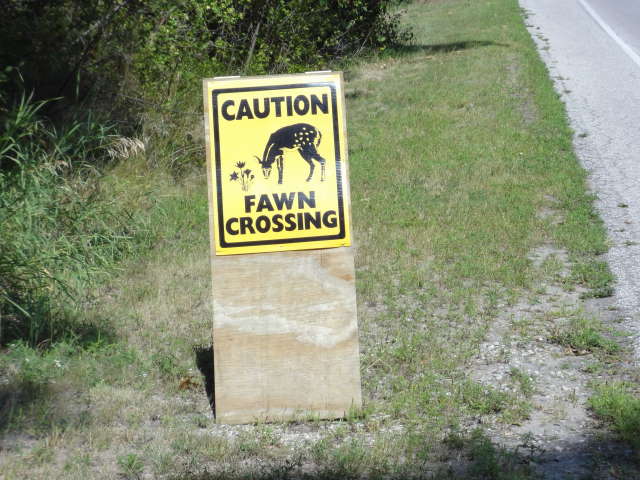 April 6th Thursday afternoon was so warm and sunny. I took my camera and wildflower book to the park where I had seen some tiny purple flowers blooming. I must have been laying on the ground for over half an hour, looking through the pictures in the flower book and carefully reading the plant descriptions. I finally decided that what I was taking pictures of was Storksbill because of the fernlike leaves and the hairy flower stems. In the same area, I discovered another tiny pink flower growing. It was orchid-like in shape, but only about one quarter inch in size. I could not find anything like it in the book - I hate it when that happens. Meanwhile, in my back yard, the viburnum is blooming now and the sweet smell hits me as soon as I walk out the back door. When I planted that bush it was less than two feet high, and now it is taller than my one-story house.
April 6th Thursday afternoon was so warm and sunny. I took my camera and wildflower book to the park where I had seen some tiny purple flowers blooming. I must have been laying on the ground for over half an hour, looking through the pictures in the flower book and carefully reading the plant descriptions. I finally decided that what I was taking pictures of was Storksbill because of the fernlike leaves and the hairy flower stems. In the same area, I discovered another tiny pink flower growing. It was orchid-like in shape, but only about one quarter inch in size. I could not find anything like it in the book - I hate it when that happens. Meanwhile, in my back yard, the viburnum is blooming now and the sweet smell hits me as soon as I walk out the back door. When I planted that bush it was less than two feet high, and now it is taller than my one-story house.
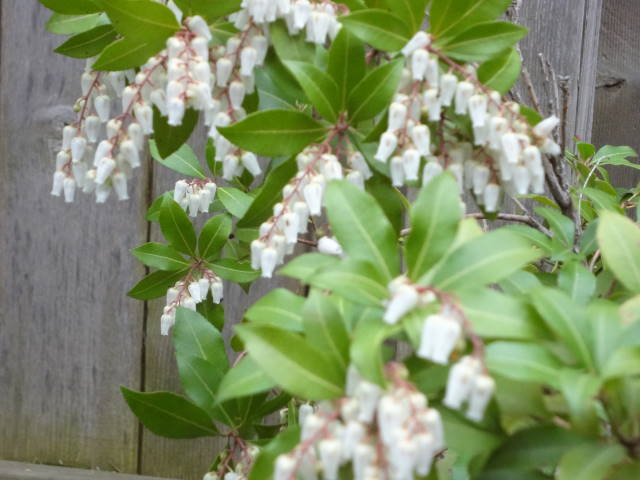 March 18th, 2012: We're having a heat wave, a tropical heat wave. So many things are blooming early and some of them are in my back yard. Cute little purple flowers are peeking out from the myrtle all over the yard, and for the first time in three years, the pieris is covered with tiny white flowers. I love my little yard.
March 18th, 2012: We're having a heat wave, a tropical heat wave. So many things are blooming early and some of them are in my back yard. Cute little purple flowers are peeking out from the myrtle all over the yard, and for the first time in three years, the pieris is covered with tiny white flowers. I love my little yard.
October 27th: By the time it stopped raining and started drying up it was after dinner and quite dark and cold. I couldn't psyche up for a ride
around Belle Isle, so I got on the Trek and headed for the Dequindre Cut to ride five laps (10.4 miles). On the first lap after I made my u-turn at Woodbridge and started north, I saw an animal right by the pavement a ways up. I immediately sensed that it wasn't a dog or cat so I started riding faster. By the time it moved back away from the path a bit I figured out that it was a fox. It just watched me speed by. Of course there were no other nuts exercising in Cut besides me, so no one to say "Did you see that?" to. I saw the fox on two other laps, as well - a frisky little animal. I must confess that it made me more nervous when I couldn't see the fox than when I could. Even this late in the year there was still some evening primrose blooming - its flowers open in the dark.
May 29th, 2011: I got tired of trying to guess what wildflower I was seeing all over the place in fields and in
Dequindre Cut, too, so I just pulled one out and carried it home on my bike. It was easier than taking one of my wildflower
books over to the Cut. As I suspected, it is common winter cress. I just planted my specimen in the back yard.
If the plant survives the trauma of transplanting, I will put a picture of it here to celebrate.
Uh oh - maybe I should have washed my hands after touching it. (See trout lily, below.)
Any time I find myself outdoors I am always on the lookout for wildflowers. I want to see what is growing; what
is blooming. Whether I'm walking, jogging, or bicycling, I am also looking. One of my favorite places to
look is the State of Michigan wetlands park on the riverfront, and the Dequindre Cut is good, too. The little chart below lists
the wildflowers that I have seen blooming in Detroit during this calendar year. I will add to the chart as I have time.

My Front Yard
After years of disappointment with flowers that never spread, never got big, flat-out died, I finally figured out the
right ones to plant in front of my house. I had never planted impatiens in my life, but I was aware of their
reputation for doing well in either shade or sun. That's the problem in front of my house. The huge Bradford
Pear tree throws part of the flower bed in deep shade, while the one corner gets plenty of sun. So I decided to give
impatiens a try, even though I am not wild about the way they look. I bought two flats of red and one of white.
There were 96 plants per flat, so that meant a whole lot of planting. I planted alternating red and white diagonal
stripes in the front, and solid red lining both sides of the walk and between some of the bushes on the right. Before
long they bushed up and now it looks so sharp. The plants filled in leaving no bare spots, there are no weeds coming
through, and there is no flower maintenance. I already know what to buy next year - maybe a variation in color, but not
in type.
The Back Forty

I am not talking about forty acres, here, but more like forty square feet - well, maybe a little more.
I prefer to call my back yard cozy. My neighbor's yard to the left has a huge maple tree whose branches
extend over half of my yard. That maple, along with my large burning bush, provide a shady canopy for the patio.
The swing's awning and the umbrella on the patio table make the space even more cocoon-like. It's so
delightful to dine outside in those surroundings.
The back yard is great for reading and sleeping, too. When I lay down on the swing, day or night, it is
usually a matter of a only a few minutes before I am gone. It's such a nice feeling to lay down, not caring
whether or not I fall asleep.
I cook on the natural gas barbecue almost every day, even rain and snow don't stop me. I have actually baked
brownies in the barbecue so I wouldn't have to heat up the house with the oven. If I include the time I spend gardening,
I guess I spend quite a lot of time out back.
In the common area behind my yard stand several huge pine trees - one of which is right outside my back gate. For the last
few years, under that pine has been growing some Solomon's Seal. In 2011, that solitary stalk was looking particularly
vulnerable to possible extinction from the indiscriminating grounds crew, so I carefully transplanted it inside my back yard.
It seems to be doing well in its new location.
Myrtle is my favorite choice for a ground cover, and I have been encouraging it to spread between all the bushes in my yard.
Here's a list of the plants in the back yard, and a picture from a Sunday dinner on the patio with the boys and their
"Nanny", my mom, that is.
Pictured at the left is a sansevieria plant that is normally indoors at the top of the basement stairs. It is also known as
mother-in-law's tongue or snake plant. One day when I was walking up the stairs I smelled something funny. I looked at
the plant and was amazed to see a tall stalk of white flowers - actually their were four such stalks. I wasn't even aware that
the plant was capable of getting flowers. I sorta like the exotic look and smell of the flowers. There are drops of
nectar on the stems at each flower.
- aralea five-leaf
- arbor vitae
- azalea (deciduous)
- azalea (evergreen)
- burning bush
- chives
- clematis
- cotoneaster
- euonymus emerald gaiety
- euonymus sarcoxie
- forget-me-not
- holly
- myrtle
- parsley
|
pieris japonica
peony
pyracantha
rosemary
Solomon's Seal
spirea blue mist
tomato
trout lily
true geranium
veronica
viburnum
weigela
weigela variegated
|

|
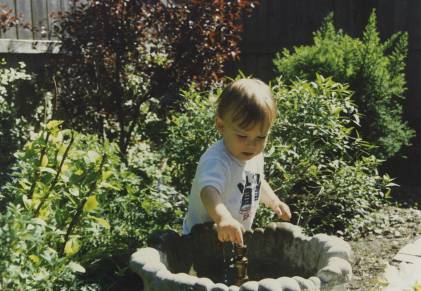 |
 |
Nate & Fountain
In the middle of the back yard is a large cement planter that I converted to a fountain. It is supplied by an underground garden hose, and has a nozzle
that will send an extremely thin steam of water straight up fifteen feet or more (or less, too.) Nate is investigating whether or not he can stop the spray.
|
Bleeding Heart
I no longer have this plant in my yard, but when I did, it looked like this. Until Nick got a hold of it, that is. One day he came into the house, so proud,
with his hands full of beautiful bleeding heart flowers that he had picked for his mom. It was a short blooming season for the plant that year.
|
This Wild Wildflower Photographer
It was Theresa (my ex-wife) who opened my eyes to the world of wildflowers. On one of our first trips up north, she bought an excellent handbook called Michigan
Wildflowers by Harry C. Lund - my favorite book of its type. We started trying to identify the many flowers which we spotted in fields, by the edges
of the woods, in the woods, and by the shores of streams and lakes. There were so many different flowers, and their beauty was awesome. At one point,
it occurred to me that it might be fun to take pictures of the wildflowers, and a new hobby was born. I bought a macro lens that cost more than my Pentax
SLR camera. That kind of lens is designed for close-up photography from distances even less than one inch. Amazing detail is possible and photographs
of the really tiny wildflowers can show them larger than just a dot. Theresa consults the book at Ocqueoc Falls.
|
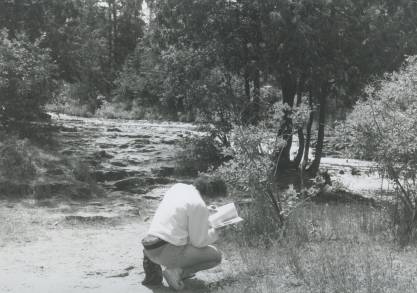 |

|
I soon became fanatical, shooting half a roll on one flower, trying to make sure I got a good photo. On our frequent up north vacations, when we would go
for a walk, the first thing my sons would ask was, "Are you bringing your camera?" If the answer was "yes" they would groan. After fifteen years of
photographing wildflowers, in spite of my declining eyesight, I consider myself an expert at spotting flowers. I can identify more than 150 different
wildflowers by sight, and many of them by their greenery. I have gotten to where I can identify wildflowers from a long distance just by the shade of yellow
or purple. My relationship with my wildflowers is personal - for most of them I can remember where I first saw them, and where I can usually find them.
It has been a couple years now since I've shot any flowers, but I still love to go to natural areas whether I take my camera or not. I have hundreds of
unsorted wildflower photographs. Some of them are quite nice, if I do say so myself. Here is a small sample from my collection of wildflower photographs.
In the photo captions I comment on some of my favorite places to look for flowers, and some of the lengths I've gone to in getting my photos.
|
The photo of the brilliant red dragonfly above was taken at Skegemog Swamp in August of 2011, and the photo at the right is the swamp itself from the obersation deck.
Most of the greenery surrounding the little pond is growing in water - a huge swamp.
The flower pictures, and almost all of the pictures on this website are new or old photgraphs that have been scanned into digital form. In person, the clarity of the
pictures is better, of course.
|
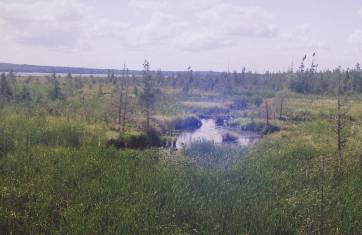 |
My Wildflower Pictures
An alphabetical index appears at the bottom of this page. (or soon will)
1
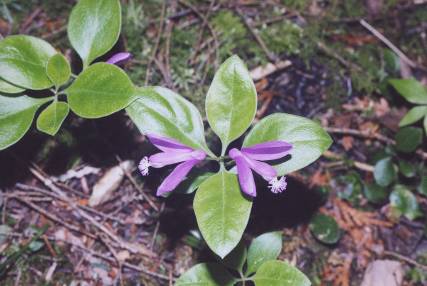 |
 |
Fringed Polygala
Some wildflowers like a habitat located at the particular edge of the woods that is by a sandy lake shore (Huron, in this case.) Polygala is one such flower.
I found it growing at the end of the Keep Out Trail - it was one of the first wildflowers I ever photographed.
|
Turtlehead
North of Presque Isle is an area called Thomson's Harbor. Off US-23, take Old State Road to Thompson's Harbor Road to its end. It is a wonderful
secluded area at the Lake Huron end of a stream that connects to Grand Lake. The stream is dammed up into a swampy area, and trickles through a rocky
trench to Lake Huron. One time we saw little snakes in that stream. There are always lots of great things growing there, sometimes including
turtlehead. I also found turtlehead growing right out of a crack in the old bridge support upriver from Ocqeouc Falls.
|
2
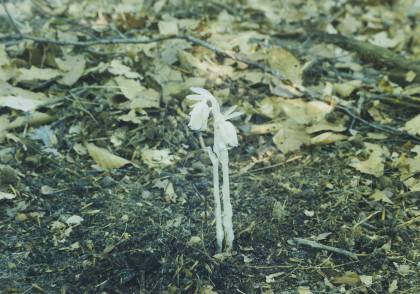 |
 |
Indian Pipe
This plant has taught me to recognize the bark and leaves of a beech tree. That's because Indian Pipe is noted for growing under beech trees from their roots.
I have walked through the woods, looking under every beech tree I could spot. It doesn't help that sometimes the fallen leaves almost cover the low-growing
Indian Pipe. I have found it growing up north on both sides of the State.
|
Cardinal Flower
These bright flowers are true red. I have found them in a bunch of places - usually in the woods by the side of a stream. The Ojibway Prairie in Windsor,
Ontario, Ocqueoc Falls, and the Sanilac Petroglyphs Historic State Park are the places I have seen cardinal flower by streams. Those in this picture, however, I
found growing in a power line "cut" on East Grand Lake Road. The red of the flowers pales in comparison to all the blood I sacrificed to mosquitos while taking
photos there.
|
3
 |
 |
Shinleaf
I have only found this highly suggestive plant in one place. Along the shores of Lake Huron I have frequently observed that where the shore ends, there
will be a narrow ridge of pine trees, followed by a narrow sandy strip that is relatively clear of trees before the real forest begins. In that sandy space will
be low-growing shrubbery like juniper and bearberry, with its cute white flowers. This shinleaf was growing maybe fifty yards to the
left of the end of the Keep Out Trail. It was well worth wading through the juniper to find it.
|
Water Hemlock
This plant is fatally poisonous to animals and humans. The Michigan Wildflowers book says that all parts of the plant are poisonous even in small amounts.
It is growing on the left about half way along the road into Skegemog, and on the right side of the path to the ponds at Seven Ponds. The plant is a member of the
carrot family. I sure hope that nobody thinks that it looks like an herb and decides to sample it.
|
4
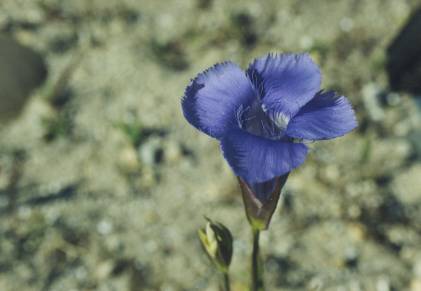 |
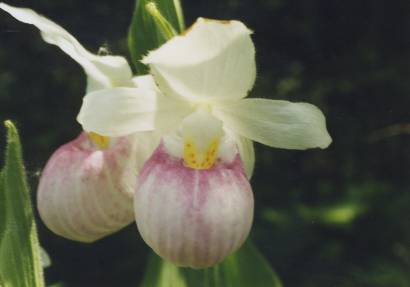 |
Fringed Gentian
I have found these fall-bloomers growing on the shores of Lake Huron in Presque Isle. The single flowers
grow on long thin stems, and are continuously bobbing in the ever-present winds. For the purposes of photographing such non-stop flowers, I
devised a clamp to hold them still. I used an alligator clamp large enough go around a stem without squeezing it, and attached the clamp to thick
aluminum wire (what they used to use for clothes lines.) In the plastic at the top of the legs of my little tripod I drilled a hole that would hold
hold the aluminum wire firmly. The wire is easy to bend, but firm enough to stay put. Since the winds up north never cease, my clamp has come
in handy many times.
|
Showy Lady's Slipper
In the spring, these beautiful flowers can be found at the edge of the woods, off to the side of the one mile long railroad right-of-way that leads to my
favorite natural area - Skegemog Swamp. It is located southeast of Torch Lake. Take the road south out of Alden and near Rapid City on the right
side or the road, the trail head has a tiny parking lot. Actually the right-of-way itself is
a great place to observe flowers, and is part of why Skegemog is my favorite. More than once have I gone on family trips to Theresa's brother-in-law's cottage
at Lake Bellaire that I would gladly have skipped, solely so I could walk that particular mile. I must be a masochist because a walk down that long country
mile with no shade from the hot sun guarantees a constant entourage of carniverous flies buzzing around my head and neck, and continuously biting. By the time I
make the turn into the woods, I am more than ready to take mosquitoes in trade for those sun-loving flies.
|
5
 |
 |
Grass Pink
Besides the Keep Out Trail, there is another, shorter path to Lake Huron that ends at what used to be a pond. Freddie's Pond Trail ends at a swampy area
with large frog ponds and lots of pitcher plants and such growing everywhere. For one brief period of the season, these brilliant grass pinks add a lot
of color to the landscape.
|
Autumn Wild Onion
This exotic-looking flower was growing on Belle Isle in a low part of the field just east of the former Detroit Boat Club. At that time the people who
mowed the Island's grass were leaving that low part of the field unmowed like a microscopic natural area.
|
6
 |
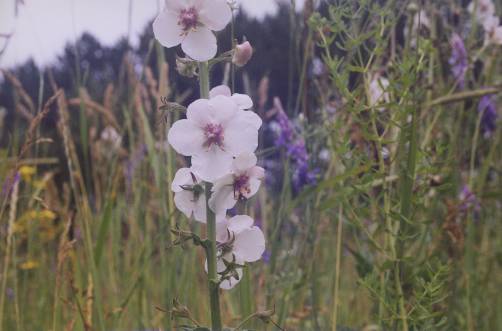 |
Moth Mullein - Yellow
These flowers grow off the sides of extremely vertical stems. The yellow ones grow on Belle Isle in a couple places: behind the nature center,
and to the north of the north path to the lighthouse.
|
Moth Mullein - White
I have photographed the white version of this flower near the road side in a couple places west of Lake Bellaire.
|
7
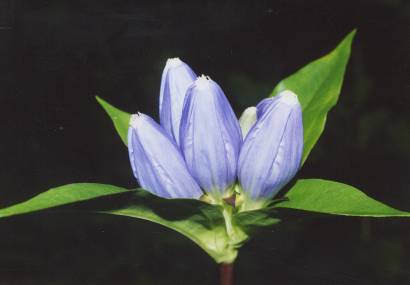 |
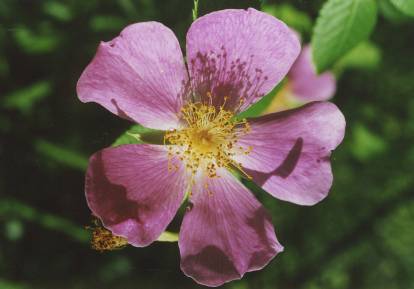 |
Closed Gentian
I have only run into these one time - at Ocqueoc Falls. I can't even remember how I found out about Ocqueoc, but after the first visit, it became a mandatory
stop on any trips to Preque Isle County (Camp Chick.) On the first time to Ocqueoc Falls, Tish and I walked the several-mile-long loop of the Bicentennial
Pathway, there. The trail was not well marked, and we got hopelessly lost. When we finally found our way back onto the trail, we were so turned around
we didn't even know which direction of the trail we should take. The "falls" themselves consist of a fast-moving stream that keeps dropping in steps over the
rocks. In a couple places the stream is dammed up so that a pool forms. The best thing to do at Ocqueoc is to swim in the largest pool which is formed
by some huge rocks. That pool is deep enough for diving into off of the upstream rocks.
On the far side of the stream, in a small clearing between the woods and the stream-side vegetation, I had the luck to find some beautiful specimens of closed gentian.
On subsequent trips I couldn't even find the same clearing, let alone the gentians. The falls are on the north side of M-68, a bit west of Rogers City.
|
Smooth Rose
Photographed at Grass River - grows everywhere up north. When we would stay at the cottage on Lake Bellaire, besides Skegemog Swamp, the
other place I liked to visit was the Grass River Natural Area. There I bought my
Got Blood? T-shirt with a large picture of a mosquito. One time at Grass River I had left a camera lens in the car and went back to
get it. Later when the boys and I returned to the car, someone parked near us alerted us to the fact that several squirrels had been picnicing
in my minivan. Apparently when I had gone back for my lens, I had left the sliding door wide open, and the menu at Minivan Restaurant featured
a cereal box on the back seat.
|
8
 |
 |
Arrowhead
At the north end of Alpena is a great island park. There is much to photograph - not just flowers, but turtles, waterfowl, and other
animals. Practically across the street (U.S. 23) from the park is the
Jesse Besser Museum. If you are ever near Alpena, don't miss this wonderful
little museum.
This brings to mind my son's first joke. Nicholas couldn't have been more than six years old and our family was
about to embark on a cultural outing. Nick said, "Are we going to the moo-seum?" I said, "No, if it were a moo-seum they would have
nothing but cows. We're going to a mew-seum." Without a second's hesitation, Nick asked, "Does that mean they have nothing but
cats?" I like to take credit for Nick's sense of humor.
|
Indian Paintbrush
It seems to me that no photograph could ever do justice to the beauty of the Indian paintbrush. They always look so much brighter in real
life. These were growing among the pitcher plants way behind the shore of Lake Huron. The thin stems in this picture remind me of
the many times I would pull up stiff grass and gather twigs to build a little teepee-shaped structure around the stem to stop the plant from
bobbing in the constant wind. Without such a structure or a clamp, it would be simply impossible to photograph many of the wildflowers up north.
|
9
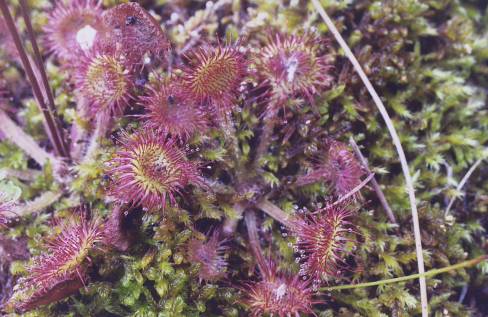 |
 |
Round-leaf Sundew
It was my good friend, Tom Allenson (Nick's Godfather) who introduced me to this miniscule plant. It is so small and inconspicuous, I never
would have even thought of looking at it. Back behind the wide Lake Huron beach which is often more rock than sand, sometimes I will find a
band of lower land that is like a mini-wet lands. There is such an area to the north at the end of the Keep Out Trail. There are a
bunch of tiny ponds connected by a tiny sort of stream. The larger ponds are just loaded with frogs, and the whole area has a lot of moss.
It is on top of that moss that sundew likes to grow. Sundew traps and digests small insects on its sticky pods. If you look
carefully at the two o'clock pad on the rightmost sundew, you can see a tiny insect whose flying days are over.
|
Sundew Flowers
Only saw this type of sundew blooming one time. Photographing flowers this short requires me to get down pretty low so I can look through
the camera lens. I always keep a pair of old volleyball knee pads in my camera bag so I don't have to kneel on little rocks and such. Frequently,
though, I will actually lay down on the ground - be it swampy or in the woods - to get my pictures. Since I always wear shorts and short socks, I am
assuming that I must be immune to poison ivy because I am sure I have come in contact with it numerous times.
|
10
 |
 |
Butter and Eggs
The flowers are pretty. Unfortunately the scraggly looking greenery of the plant is not. I have seen a bunch of these around Detroit in later
summer. In fact, there seemed to be more each year for awhile, but now I am seeing less. I've noticed year-to-year trends in the Detroit
presence of other wildflowers, too: goatsbeard, everlasting pea, and boucing bet, for instance. Some wildflowers seems to spread along
corridors in Detroit. I am constantly surveying the fields to see what's growing as I drive through the city.
|
Bearberry
This low-growing ground cover with it's attractive dark green leaves can be seen in abundance covering the sand at the edges of forests. I transplanted
some to my backyard where it grew for quite some time. This picture is from my yard, in fact. Its tiny flowers are just as cute as can be.
|
11
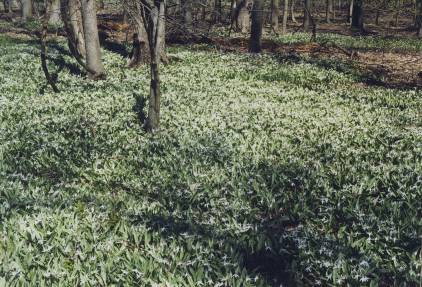 |
 |
Trout Lily
When these bloom in the forest it looks like a carpet of white (there is a yellow version, too.) Besides up north, I would see trout lilies every
spring when I would take the boys on walks through the woods on Belle Isle. I have photographed them en masse on several occasions, but the pictures
never do justice to the beauty of the scene. This shot is from Belle Isle, along the path by the red bridge at the west end of Lake Okonoka.
|
Trout Lily
Spring of 2009, I got the crazy idea that it would be nice to have trout lilies in my own back yard, which is pretty shady. One morning, armed
with a shovel and a plastic bag, I dug up about twenty of them (and about the same number of cut-leaf toothwort
which was also blooming), and transplanted them from Belle Isle to the corner of my back yard. Once I had them planted, I realized that that corner of the yard
actually gets a little direct sunlight for a short period of the day. Since these forest plants don't like much light, you could say that planting
them where I did was both "not too bright" and "too bright" simultaneously. Transplanting them at all was not too bright because I promptly got
something that looked like leporosy on my legs - my doctor attrributed it to contact with oil from the plant roots. It just wouldn't go away, and my
doctor was ready to send me to a dermatoligist. Note to self: wear long pants and gloves next time, and then
wash everything cloth, and the shovel in hot water. Or maybe there just shouldn't be a next time?
|
12
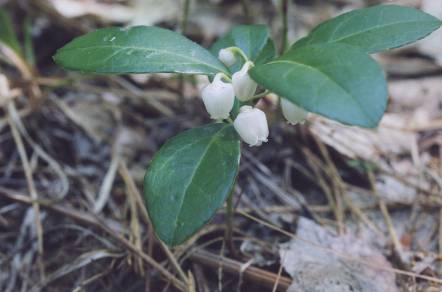 |
 |
Teaberry
Remember Clark's Teaberry gum? I used to love that stuff, and I guess some places still sell it. Teaberry, also known as wintergreen, grows
in forests. Though it is inconspicuous, I can alway recognize it by the shade of green of its leaves. Breaking one of the leaves releases that
familiar smell that I happen to love. If you have smelled Pepto Bismol or Icy Hot, you've smelled wintergreen. Writing about this reminds me
of the spicy jelly beans I like. They come in an assortment of seven yummy flavors: wintergreen, anise, cinnamon, peppermint, spearmint,
sassafras, and my favorite, clove. You can buy them online at George Howe Candy.
|
Yellow Pond Lily
Sometimes I take pictures of aquatic plants like this by rowing a boat up very close and photographing from the boat. For this picture, however I
decided that the boat was just not quite steady enough. I had rowed across Lake Bellaire and into the stream that connects to Clam Lake (on the
"Chain of Lakes.") The water was not even two feet deep, so I decided to step out of the little rowboat to get some better pictures. I
immediately sunk into the soft silt until the water was up to my armpits! Holding my camera over my head, I was getting ready to throw it back in
the boat until I finally stopped sinking. I got my pictures, but I was a mucky mess. Good thing that I wore my bathing suit.
|
13
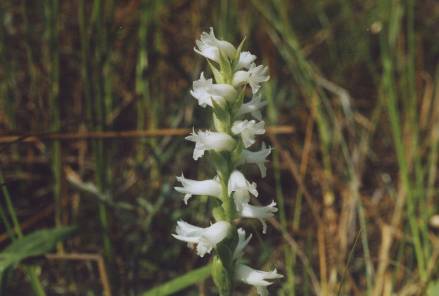 |
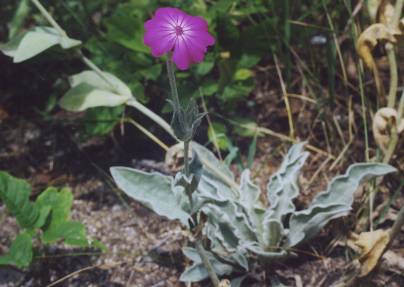 |
Nodding Ladies' Tresses
When I scan the drab green and brown vegetation behind the Lake Huron shore, it is such a treat when a glint of bright white enters my field of vision,
because I know it is going to be these beautiful flowers.
|
Pink Mullein
Minus the flowers, this mullein looks like a junky weed. The stems and wrinkly leaves are a strange grayish color.
When in bloom, however, the pink flowers eclipse the rest of the plant. They seem to glow in the middle as if there
were electric lights in there.
|
14
 |
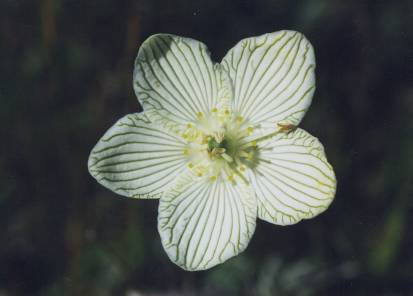 |
Swamp Candles
I've only seen these pretty little flowers in one place up in Presque Isle. They were growing in a deep drainage ditch with
tall vegetation growing behind the ditch. It was hard enough finding a time when the sun would shine on them, but setting up
the little tripod in the ditch was even more difficult. The combination of bright yellow and red is dramatically pretty.
|
Grass-of-Parnassus
These beauties are easy to find aound Lake Huron behind the beaches where the soil is stll sandy, but the water table is high.
Their bright white stands out against all the green vegetation.
|
15
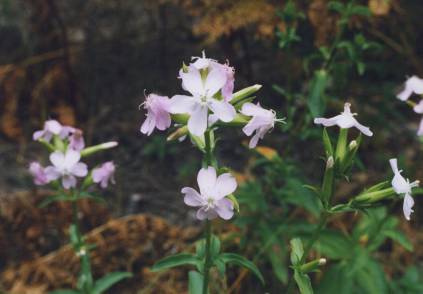 |
 |
Bouncing Bet
I first saw these on the corner of East Grand Lake Road and the road into the Bell Bay Natural Area. Now I see them all over Detroit, esecially along
Kercheval. The flowers stick straight out from the stems in four directions at 90° angles.
|
Teasel
I can guarantee you that this is one plant you would not pull out of the ground bare-handed. These babies are loaded with sharp thorns from
top to bottom. The stems are practically solid thorns, and then there are these thin curving leaves that bracket the flower clusters,
and they, too, have thorns along them, as in this picture. Teasels grow straight and tall - sometimes over eight feet.
|
16
 |
 |
Striped Coralroot
Like Indian Pipe, this inconspicuous plant grows on a short stalk from amongst the dead leaves on the forest floor. Because of its color, it is
difficult to spot.
|
Swamp Dewberry
Bright white and deep dark green - such a pretty combination of colors. Found these in western Michigan on a trip we took all the way across
Base Line Road from Grosse Pointe Shores to Lake Michigan. The road started and stopped many times so we would have to backtrack and go up or down a mile or
two to find the next part of the road.
|
17
 |
 |
Crown Vetch
Because of its extensive root structure, this plant is a favorite with highway departments. They plant it on steep slopes to prevent soil
erosion from rain run-off. I have seen it along freeways, up north, and at Kensington Metro Park.
|
Leadplant
Just one place have I seen this exotic looking plant. It was near the little pond in the middle of the prairie at Seven Ponds.
|
18
 |
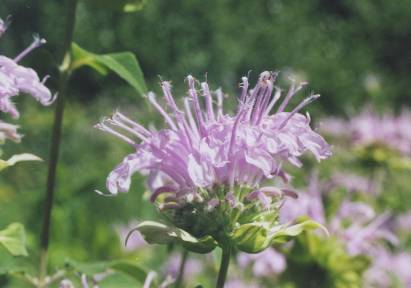 |
Catnip
This is a member of the mint family - sometimes called catmint. From a distance, the flower clusters looking boring gray, but up close,
the individual flowers are quite pretty.
|
Wild Bergamot
What I like the most about these pretty flowers are the bracts - the leaves that protrude just below the flowers themselves. The bracts on the
wild Bergamot are wavy in a nonchalant looking way. They give the flowers a sort of sexy look.
|
19
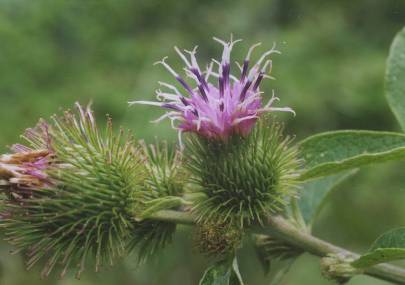 |
 |
Common Burdock
Burdock grows all over the place. There is plenty growing around Detroit, and it often shows up, uninvited, in people's yards. It is easily
recognizable by its huge weedy-looking leaves. It's the flowers that are quite pretty when viewed up close.
|
Wood Lily
Viewed from the side, these orange beauties look like ordinary flowers, but a top view, as in the photo, reveals that the six petals don't even touch each
other. Each petal is on its own tiny stem. You can look right through the flower from the top.
|
20
 |
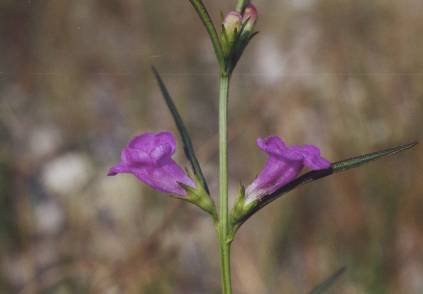 |
Common St John's wort
These grow abundantly up north near swamps and at the edges of forests.
|
Purple Gerardia
I love the way these flowers look when they happen to lay right on top of one of the green
spikes that protrude from the stalk.
|
21
 |
 |
Bladder Campion
Where I have most frequently seen bladder campions growing is by the side of a dusty road up north.
It is hard to imagine a less friendly environment - full sun and lots of dust.
|
Spotted Jewelweed
These cornucopia-shaped flowers are suspended on thin flexible stems. The stems look so fragile, I
am surprised that the ever-present winds don't blow all the flowers off. When the plant has mature seed pods, a gentle squeeze will cause the
pod to explode and shoot the seeds out (it's called dehiscence.) Pretty cool.
|
22
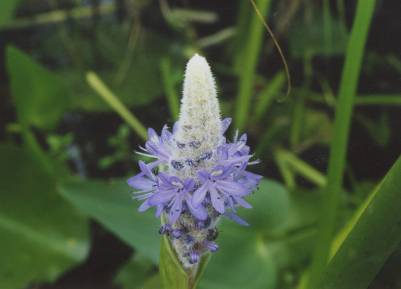 |
 |
Pickerelweed
At Seven Ponds there is a stairway bridge over the narrow water connecting two of the ponds. Just off of the boardwalk leading to the bridge, these
flowers were growing in the water. The water was far too deep for wading, so to get close enough for a picture, I knelt at the edge of the dock, and
had my sons sit on my legs - one on each leg. Then I stretched straight out over the water and got my close-ups. It was hard to straighten back
up onto the dock.
|
Wild Basil
|
23
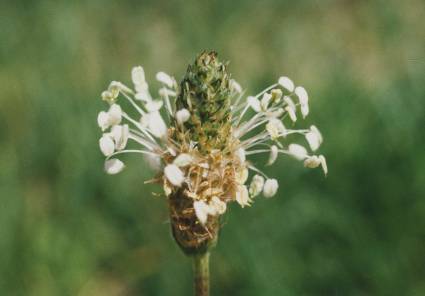 |
 |
English Plantain
Ask anyone whose lawn is plagued with these ubiquitous plants and they will categorize them as weeds rather than wildflowers.
|
Fireweed
Photographed near the Bell Bay Natural Area in Presque Isle County.
|
24
 |
 |
Compass Plant
These are the tallest wildflowers I have photographed. It was in the prairie at Seven Ponds. The plant's leaves always align north-south, hence the name.
|
Bittersweet Nighshade
We go way back. I can remember nightshade growing in the back yard when I was a child. I also remember being warned that it was poisonous - probably
because the berries, once they would turn orange and then red, looked so succulent and appealing.
|
25
 |
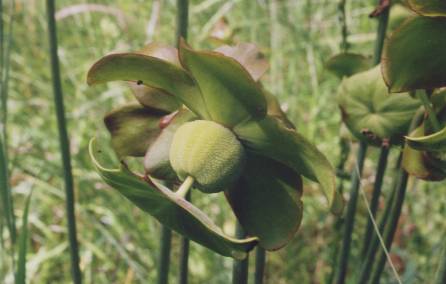 |
Great Lobelia
|
Pitcher Plant
These grow by the hundreds in wet areas. My picture is of the flower, but the water-holding tubular pitchers at the base of the flower stem are
what give the plant its name. The flower heads are sometimes green, and sometimes dark maroon in color.
|
26
 |
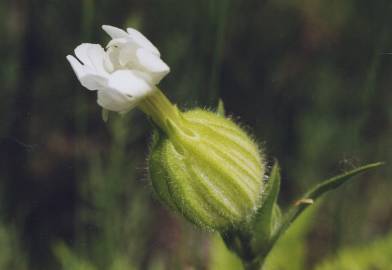 |
Bull Thistle
Bees seem to love the flowers of these thistles. On several occasions I have taken super close-up photos of said bees.
|
Evening Lychnis
Also known as White Campion, its flowers look like they are folded up. Male and female flowers inhabit
separate plants and are pollinated by moths.
|
27
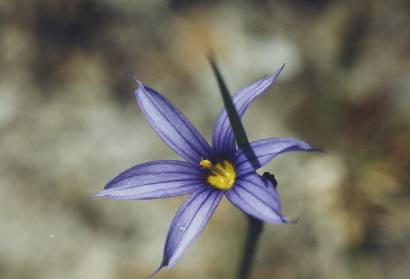 |
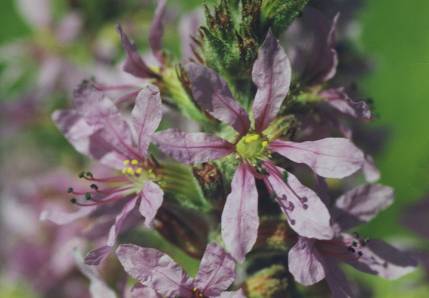 |
Blue-Eyed Grass
|
Purple Loosestrife
This wildflower, AKA Lythrum, is so invasive that planting it is prohibited. From a distance, it
looks quite purple, but up close the flowers are washed-out pink. Their tiny anthers are a startling
shade of bright electric green - not reflected in the photo.
|
28
 |
 |
Columbine
|
Yellow Lady's Slipper
|
29
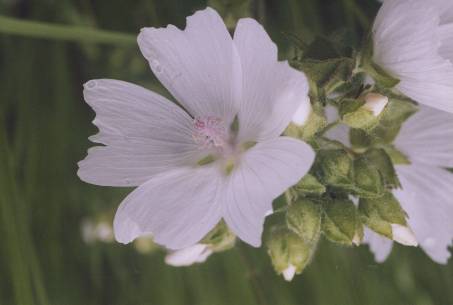 |
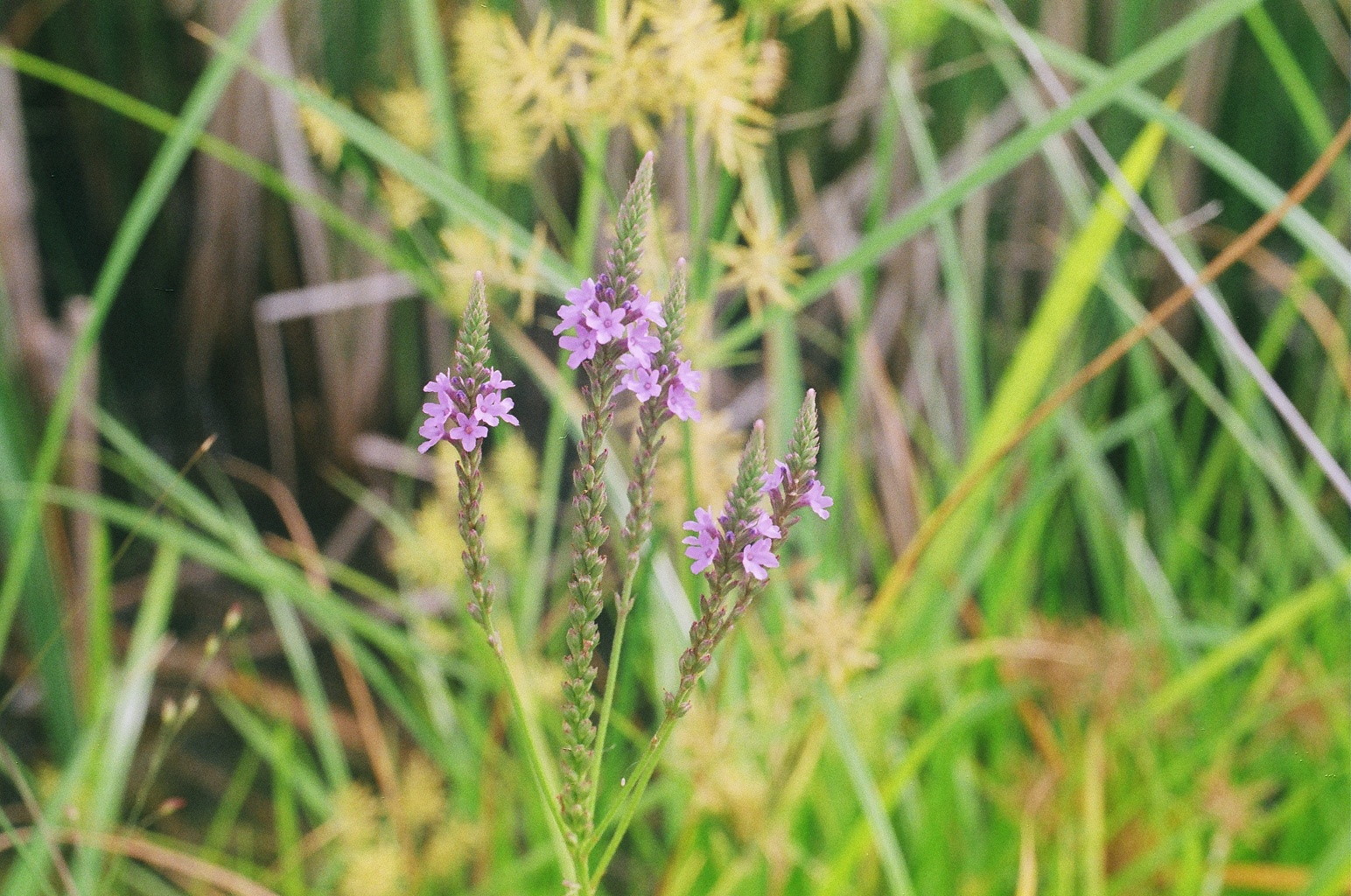 |
Musk Mallow
Photographed in the ditch by the stop sign at the northeast corner of Lynn Road and Clam Lake Road west of Lake Bellaire. I have since seen it growing on the north side of Lynn Road west of Clam Lake Road.
|
Blue Vervain
|
30
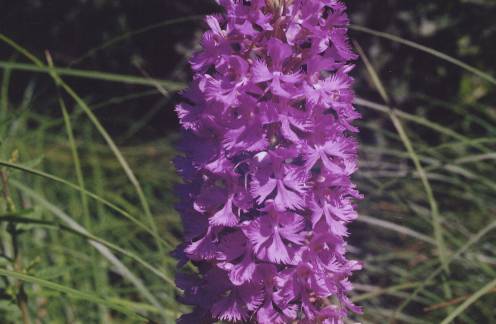 |
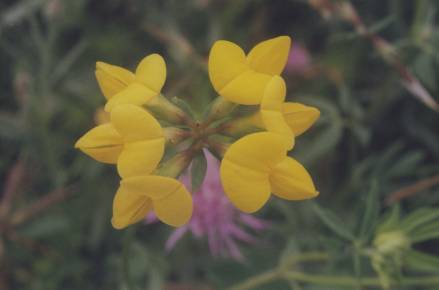 |
Fringed Purple Orchid
Quite the impressive purple display - hard to miss. Yet there was only one stalk to be seen anywhere around, and I have never seen it any other time.
It was along the railroad right-of-way at Skegemog.
|
Birdsfoot Trefoil
I had seen bright yellow patches of these tiny low-growing flowers in past years, but in 2011, I finally brought the wildflower book and identified them.
I have mainly noticed them in Detroit.
|
31
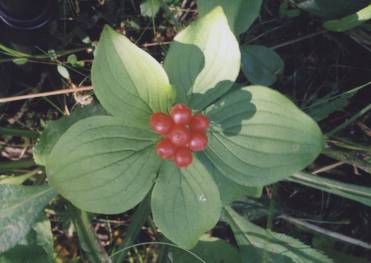 |
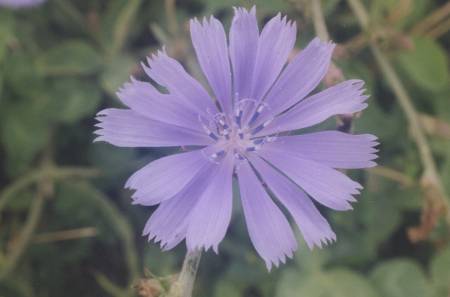 |
Bunchberry
Hard to say which is prettier - the berries or the flowers. The pure white flower lays flat on top of the green leaves with four equally-spaced petals
of a pleasing rounded shape and pointed tip.
|
Chicory
This wildflower is my nomination for the official wildflower of Detroit. Chicory grows everywhwere and looks good in masses, especially combined with Queen Anne's lace. It's
blue-purple color looks best on cloudy days rather than in the sunlight. In photographs, the color invariably looks washed-out
|
32
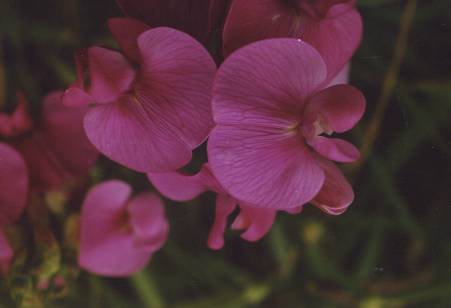 |
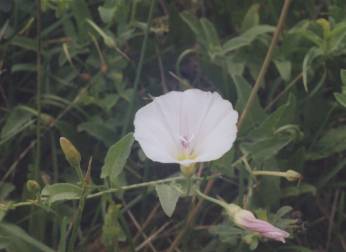 |
Everlasting Pea
This low-growing viny wildflower attaches itself to other plants with curly tendrils. I see it up north on both sides of the state, and also in some fields in Detroit. There are
often white versions of the flower present along with the pink (which is the shade of Pepto Bismol.)
|
Field Bindweed
Some patches of this flower are huge. It often will grow up a fence if there is one handy. Comes in a pink version, too.
|
33
 |
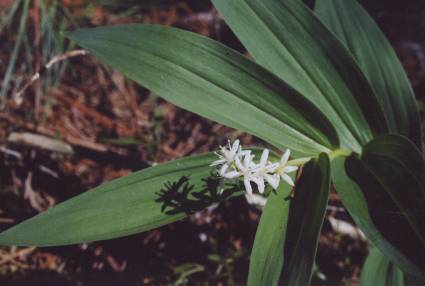 |
Silverweed
Silverweed grows abundantly on the shores of sandy lakes, always way back where the sand makes a ridge at its highest point. The bright yellow flowers
grow off the many red runners that lace the ground amidst the fern-like greenery. Normally silveweed has a nice dark green color, but a slight
reverse wind will turn the small flexible fronds over and reveal the silver colored back sides. Then it's as though the plant has changed colors.
|
Starry False Solomon's Seal
There are several varieties of Solomons seal, all of which get small white flowers. This version with the long narrow leaves is called "false" for some
reason. It's easy to spot this type of Solomon's Seal because the stems always arch.
|
34
 |
 |
Curled Dock
This wildflower undergoes some dramatic color changes as it matures. It starts out an ordinary light green color, but close inspection reveals light pink
and blue highlights on the flowers. Then the whole plant grows darker and darker - passing through maroon on the way to a very dark brown, like the color
of rusty iron. It's that color that prompted me to call it rust weed for years, until I found out that it was known as curled dock. It grows
in fields all over Detroit.
|
Beach Pea
Typical pea plant grabbing onto other vegetaion with its twiny tendrils. I found it growing on
a sandy beach, of course.
|
35
 |
 |
Dune Lily
It's strange to find flowers growing in a sand dune, and these flowers are cute with their
alternating red and purple heart-shaped anthers.
|
Goatsbeard
Like a shy dandelion, these only open in the morning, and only if it's sunny. The leaves
are more pointy than a dandelion, and the seeds form a feathery ball just like those of a dandelion,
only larger.
|
36
 |
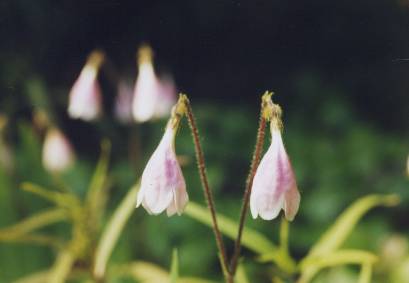 |
Dwarf Lake Iris
Even though this is a protected wildflower, it can be found in great abundance in the spring
in wet areas near Lake Huron.
|
Twinflower
This is one of the first wildflowers that I photographed. I found it at the edge of the
woods in two places on Lake Huron.
|
37
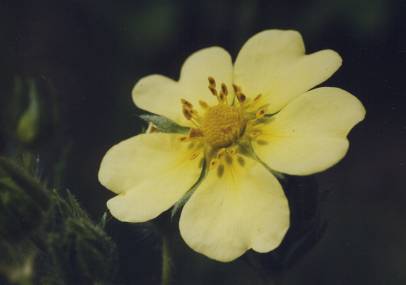 |
 |
Sulphur Cinquefoil
Also known as Rough-Fruited Cinquefoil and Potentilla recta, this beauty has five heart-shaped leaves that are the most pleasant shade of yellow.
This is one of the many wildflowers that grow in the "weed" fields at the "farm" in Ann Arbor.
|
Thimbleberry
Rather than the flower, I took a picture of the raspberry-like fruit. If I had to describe thimbleberry in one word it would be "delicious!"
When I have the good fortune to be up north at the right time of spring, it is pure delight to walk through the woods popping those tart little berries in
my mouth by the dozens. The plant has large leaves and grows at the edges of woods or along paths in the woods. It evidently needs more light
than the deep woods provides. There are several places online where you can order
thimbleberry jelly and jam.
|
38
 |
 |
Common Skullcap
From the look of its leaves and the square hairy stem, this is obviously a member of the mint family. What I find amazing is that the longish flowers
stick out so straight, seemingly defying gravity.
|
Canada Mayflower
I find Canada Mayflower growing in the filtered sunlight that makes its
way through the large trees in the forest. The charateristic zig-zag pattern of its stem is so pleasing.
|
39
 |
 |
Starflower
|
Orange Hawkweed
It's so nice to see the color orange in the middle of a field of green growth. I usually see it
up north in fields that are hardly grass, but still mowed. Then it will be blooming quite low to the
ground, but still easy to notice for it's perky color.
|
40
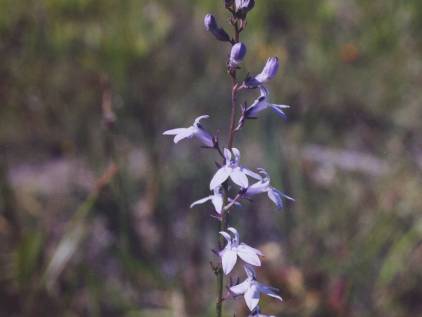 |
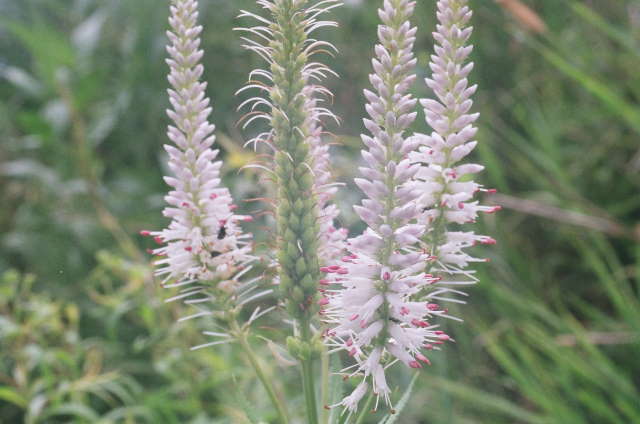 |
Indian Tobacco
|
Culver's Root
Photographed in the prairie at Seven Ponds.
|
41
 |
 |
Common Milkweed
The seedpods are much more interesting than the flowers. I love it when they leak little drops of milk right through their skin - as in the picture.
|
Common Mullein
These nice little yellow flowers have the misfortune of inhabiting what I would probably consider to be the junkiest
looking weed I've ever seen.
|
42
 |
 |
WIld Strawberry
Photographed by the parking lot at the end of the very very very long one-lane entrance road to Thompson's Harbor Natural Area north of Alpena.
|
Lady's Thumb
Escept for these tiny colorful spikes of flowers, this plant would look like any other weed growing at the
edge of the street. Yes, Lady's thumb favors one of the most hostile environments imaginable to grow -
from cracks between the street surface and the curb. I see it all over Detroit in the late summer (if I
happen to look at the curbs.)
|
43
 |
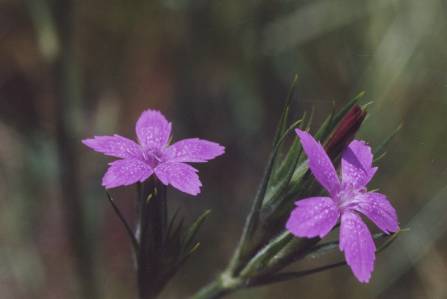 |
Self-Heal
I would always find self-heal growing along paths deep in the woods. The flowers grow on four sides of a square column which can vary a lot in height.
|
Deptford Pink
I first discovered these pretty little flowers at Seven Ponds Nature Center northeast of Oxford in Oakland County. This natural area is expecially
great because not only does it have the ponds, but there is also a large prairie with a whole different set of wildflowers. That prairie is the only
place I have ever seen compass plant or lead plant.
Last summer I spotted Deptford pink near my house, along the St. Aubin fence at the top of the Dequindre Cut. I often wonder if some of the wildflowers
that end up in the City are actually planted there.
|
44
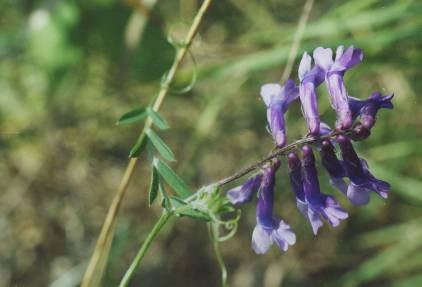 |
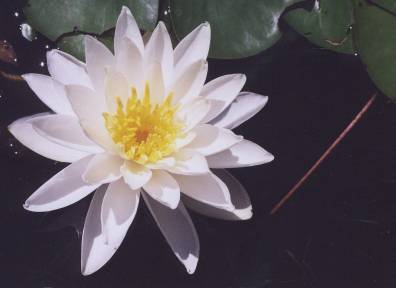 |
Hairy Vetch
I have seen a lot of this vine-like wildflower in Detroit, as well as up north. When I ride my bike to work, my usual route takes me across
Watson Street to Woodward. On the north side of Watson, I used to see hairy vetch growing in a vacant field. Then came this market
called Zaccaro's, and they paved the field for a parking lot. The market didn't survive one year. Now I get to look at unused asphalt
instead of nature's beauty. It reminds me of a Joni Mitchell song.
|
Fragrant Water Lily
|
45
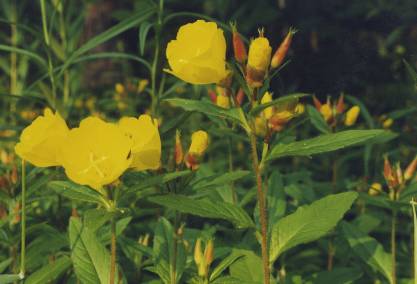 |
 |
Evening Primrose
The flowers open at night and close before midday. I have seen it's flowers when I have been riding after dark in the Dequindre Cut. At the top of the stems are reddish seed pods.
|
Canada Anemone
Photographed along the west edge of Lake Bellaire.
|
46
 |
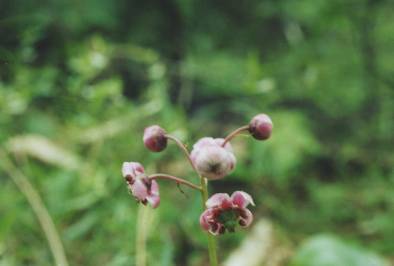 |
Horsemint
The only place I have ever encountered this mint was in a field on Alpena Island. It took a while before I could figure out what it was.
|
Pipsissewa
With its dark green shiny leaves, this plant looks similar to wintergreen. I have found it along the path through the woods at Bell Bay in Presque Isle.
|
47
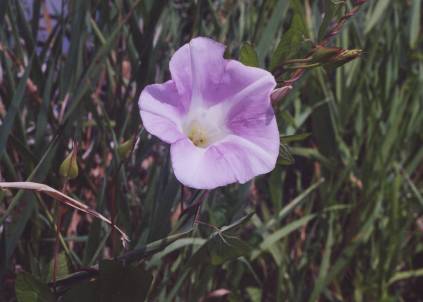 |
 |
Hedge Bindweed
Always pink with white stripes, this vine is similar to morning glory, attaching to other plants. I have seen it in the woods on Belle Isle, along the Gratiot ramp of the Dequindre Cut, and up north, of course.
|
Pearly Everlasting
|
48
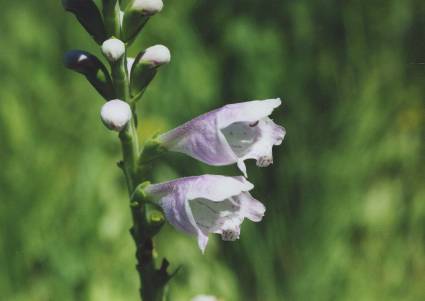 |
 |
Obediant Plant
|
Tufted Loosestrife
|
49
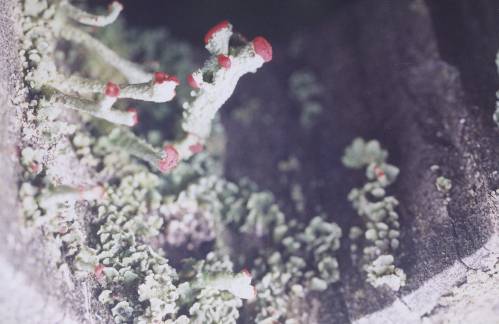 |
 |
British Soldiers
I put the macro lens through its paces with this shot. I saw this super-tiny stuff growing between the boards of a dock at a lake up north. I would never have noticed it were it not for the bright red tips which turn out to be spores. British Soldiers is a lichen - the single plant that is formed when an algae and a fungus combine.
|
Cutleaf Toothwort
This grows at the edge of the woods on Belle Isle in the spring. I have seen it up north, as well. I have also seen similar broadleaf toothwort on Belle Isle.
|
50
 |
 |
Purslane
Rarely have I seen purslane blooming. In lawns, including mine, however, this weed is far from rare. Purslane probably ranks second only to crabgrass as a lawn nuisance.
|
Red Clover
It really looks more purple than red, and is widespread in fields everywhere. The leaves of red clover have a distinctive V-shaped marking.
|
51
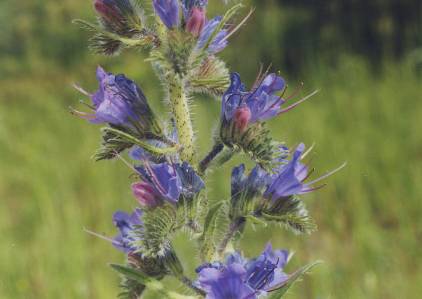 |
 |
Viper's Bugloss
Every time I have seen these pretty blue and pink flowers, I have wished I had a hose with me to wash them off. They always seem to be growing at the sides
of dusty dirt roads up north. It is also known as blueweed.
|
Daisy Fleabane
I photographed these aster-like flowers beside a path through the woods in Preque Isle. There was filtered sunlight available to them.
|
52
 |
 |
Queen Anne's Lace
This ubiquitous wildflower is also known as wild carrot. I love the way the thin bracts interlace below the flowers. The flowers are usually all white, of course, so I had to include this picture. It is one of only a couple that I have ever encountered with the ring of pink around the edge.
|
Saint Peterswort
|
53
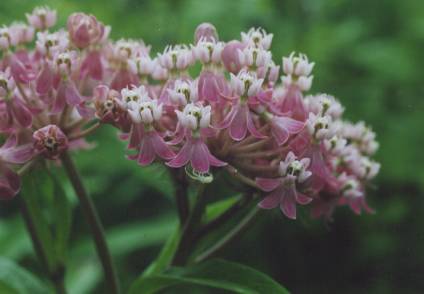 |
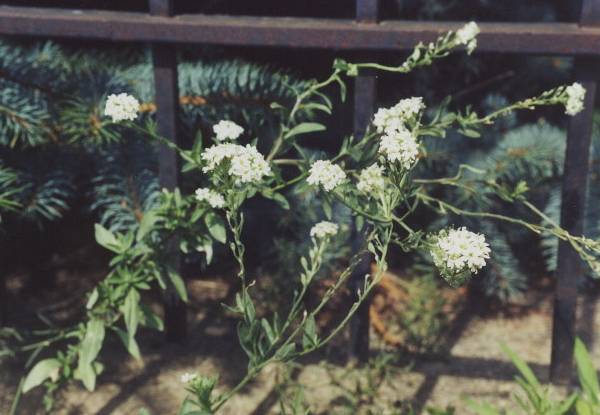 |
Swamp Milkweed
|
Hoary Allysum
Even though it's just another white flower, hoary allysum is easy to recognize. Its leaves clasp the stems in a way that makes the stems look twisted, and the color of the flowers is slightly chalky. This picture was taken at the first place I found them in Detroit - along the fence on the parking lot of Old St. John's Church which is located on Russell south of Gratiot.
|
54
 |
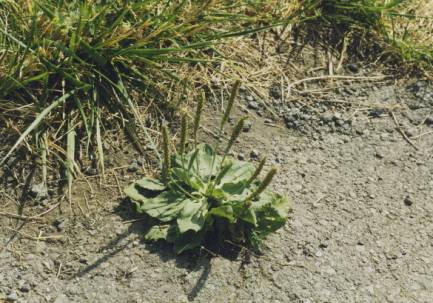 |
Sow Thistle
Sowthistle is one of several tall dandelion-like plants. These, in particular, have a lovely southward view of Windsor.
|
Common Plantain
This weed shows up in fields and lawns all over. Even without the "flower" stalks it can be recognized by the non-symetrical size and pattern of the leaves.
|
55
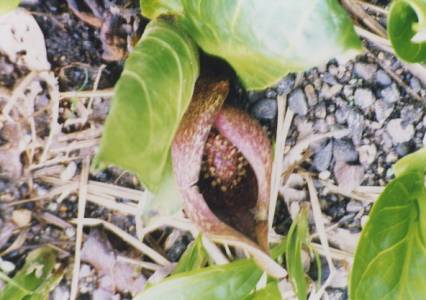 |
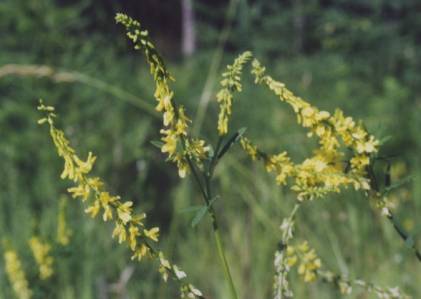 |
Skunk Cabbage
The flowers are the little yellow things on the inside. I found this during our family trip across Baseline Road from Lake Saint Clair to Lake Michigan in '98.
|
Yellow Sweet Clover
Sweet clover, both yellow and white, grows in fields all over Detroit. Where there is a bunch, you can smell its sweetness from a distance.
|
56
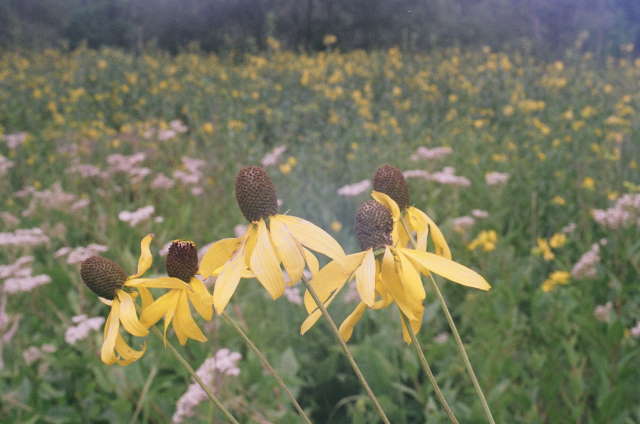 |
 |
Prairie Coneflower
|
Common Nightshade
At times, I have found this growing in both my front and back yards. Its berries are black and sort of oval. There are several in this photo, but, alas, they are not in focus.
|
57
 |
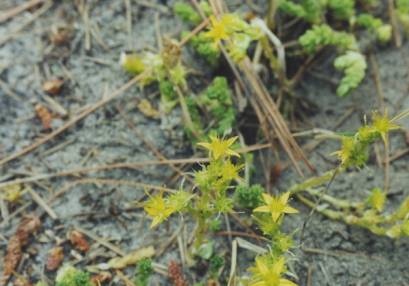 |
Mouse-ear Chickweed
One of the many odds and ends that grow in vacant fields. You would have to look carefully to notice it, and then wonder why you did.
|
Beach Heath
This was growing along the sandy path at Bell Bay Natural Area in Presque Isle.
|
58
 |
 |
Common Winter Cress
I never paid attention to this stuff before, but now I see that it grows abundantly in the fields areoud Detroit. It is the first highly noticeable wildflowers of the spring.
|
Dutchman's Breeches
This is one of the the first wildflowers I ever photographed. Then I never saw it again for many years because I had stopped going up north in the spring. I later discovered that DUtchman's Breeches grow like crazy at Pointe Pelee - the park is famous for that wildflower. The flowers grow all along the road into the park, but just on the side away from Lake Erie. In describing the quantity, "innumerable" comes to mind. Sprawled out on the ground, taking photos, I lost one developed roll of film out of my pocket, but after searching for about twenty minutes, found it. Whew!
|
59
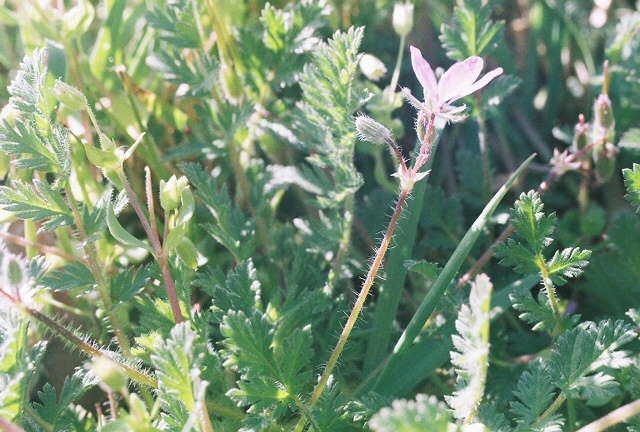 |
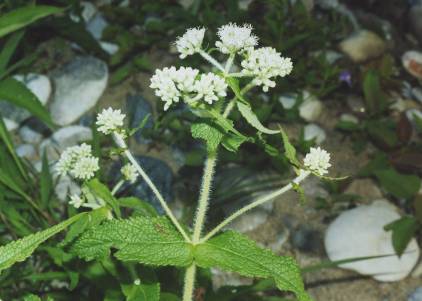 |
Storksbill
|
Boneset
|
60
 |
 |
Ox-eye Daisy
|
Honesty
|
61
 |
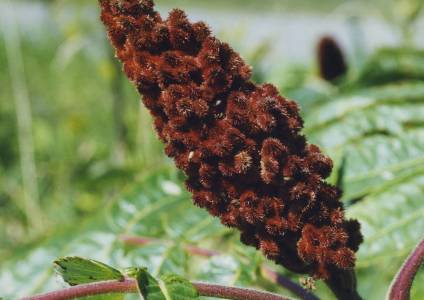 |
Spotted Knapweed
|
Staghorn Sumac
|
62
 |
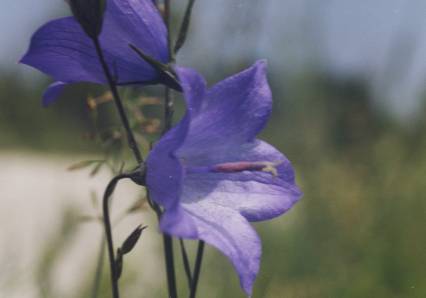 |
Crabgrass
|
Harebell
|
63
 |
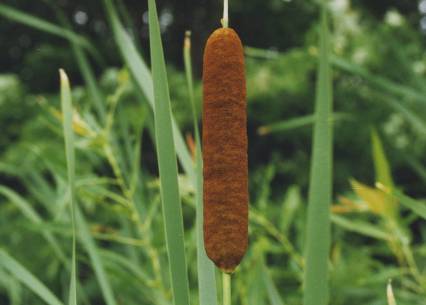 |
Canada Thistle
|
Common Cattail
|
64
 |
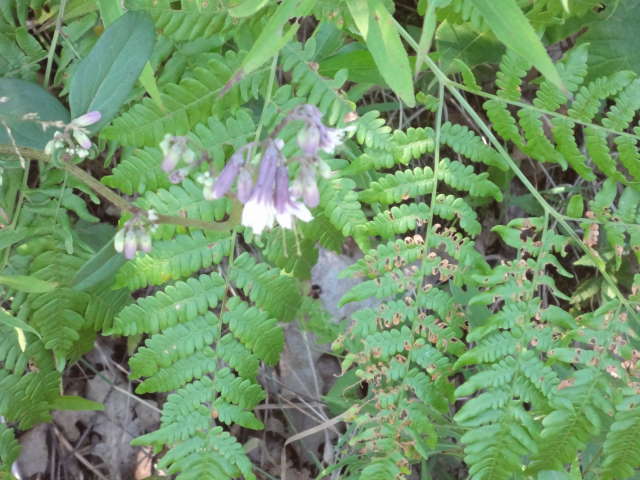 |
Sneezeweed
|
Pine Hyacinth
Found these cuties along the Pere Marquette Rail Trail. I only had my small Sony digital camera, but I like the picture anyway.
|
65
 |
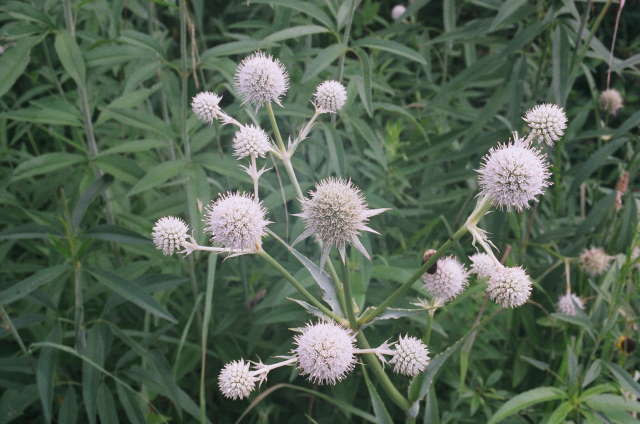 |
Prairie Blazing Star
|
Rattlesnake Master
|
66
 |
 |
Woodland Sunflower
|
Spotted Joe Pye Weed
|
67
 |
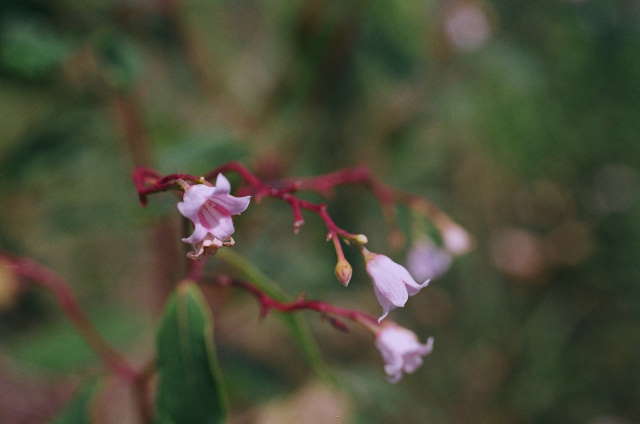 |
False Solomon's Seal
This specimen was photographed in my own back yard! It was several years ago when I first noticed Solomon's Seal growing in the common area behind my yard. Afraid the wildflower might get mowed down by our grounds crew who would take it for a weed, I transpanted a few stalks inside my back yard. Next spring I will get a picture of the flowers.
|
Spreading Dogbane
Spotted by Kathy on the bike trail between Petosky and Charlevoix.
|
68
 |
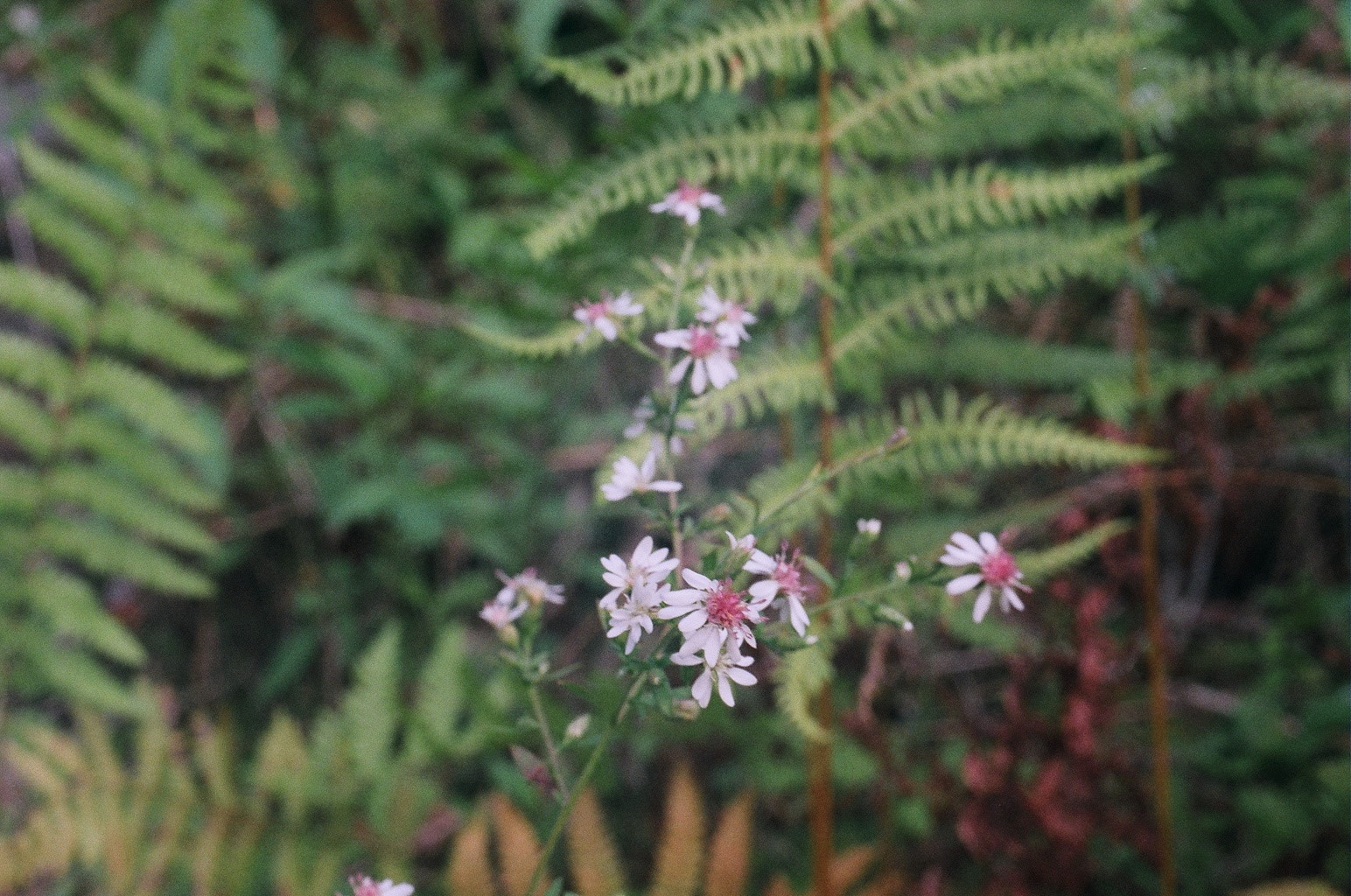 |
Chinese Lantern
People do plant these in their gardens, but the wildflower book includes it, so that's good enough for me. It is a variety of the wildflower known as ground cherry. These were growing along the designated bike trail in Charlevoix.
|
White Wood Aster
Pictured at Skegemog Swamp. Some of the flowers have yellow centers, and some red - quite a pretty combination. These little asters have become prominent in Detroit in recent years. They bloom in late summer, and I have seen the flowers persisting after the first snowfall.
|
69
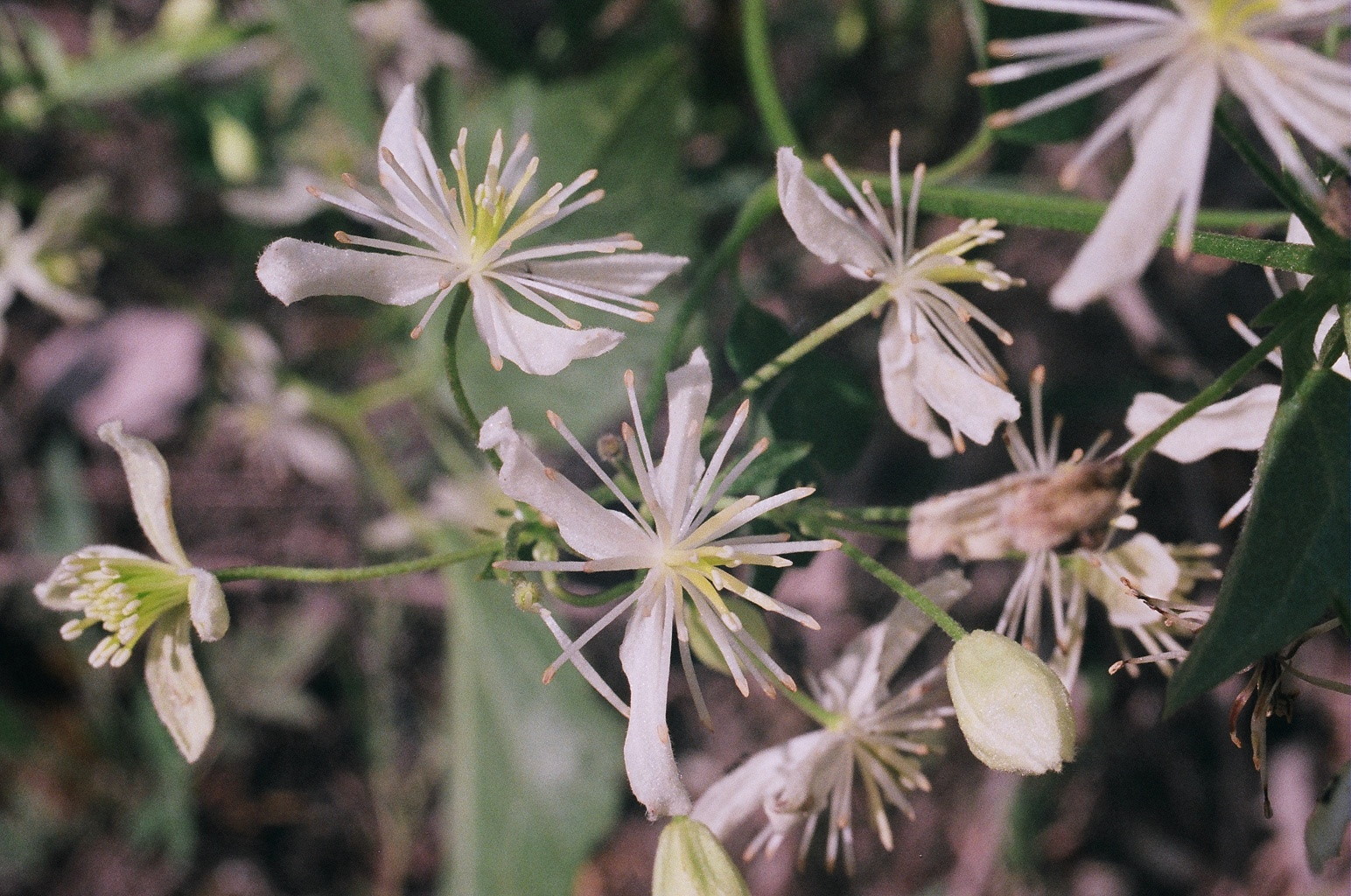 |
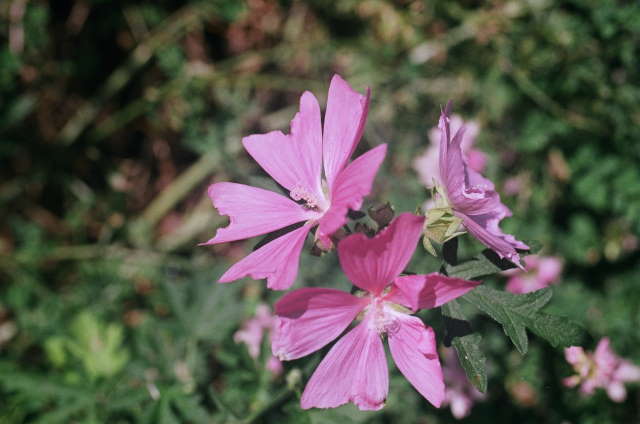 |
Tall Meadow Rue
Growing on the railroad right-of-way at Skegemog Swamp.
|
Musk Mallow in pink
There is a picture of the white version, as well. These were on the trail between Petosky and Charlevoix.
|
70
 |
 |
Bloodroot
These were growing at the edge of the forest on Camille's farm in Washtenaw County, and I didn't know what they were until I looked them up. The huge clasping leaf made it easy to ID them. I transplanted some to my back yard.
|
Trillium
First time I've run into large-flowering trillium. Again, in the woods at Camille's farm. I transplanted three to my back yard, and I photographed these in my yard with my little digital camera. I will try to get a better photo.
|
71
 |
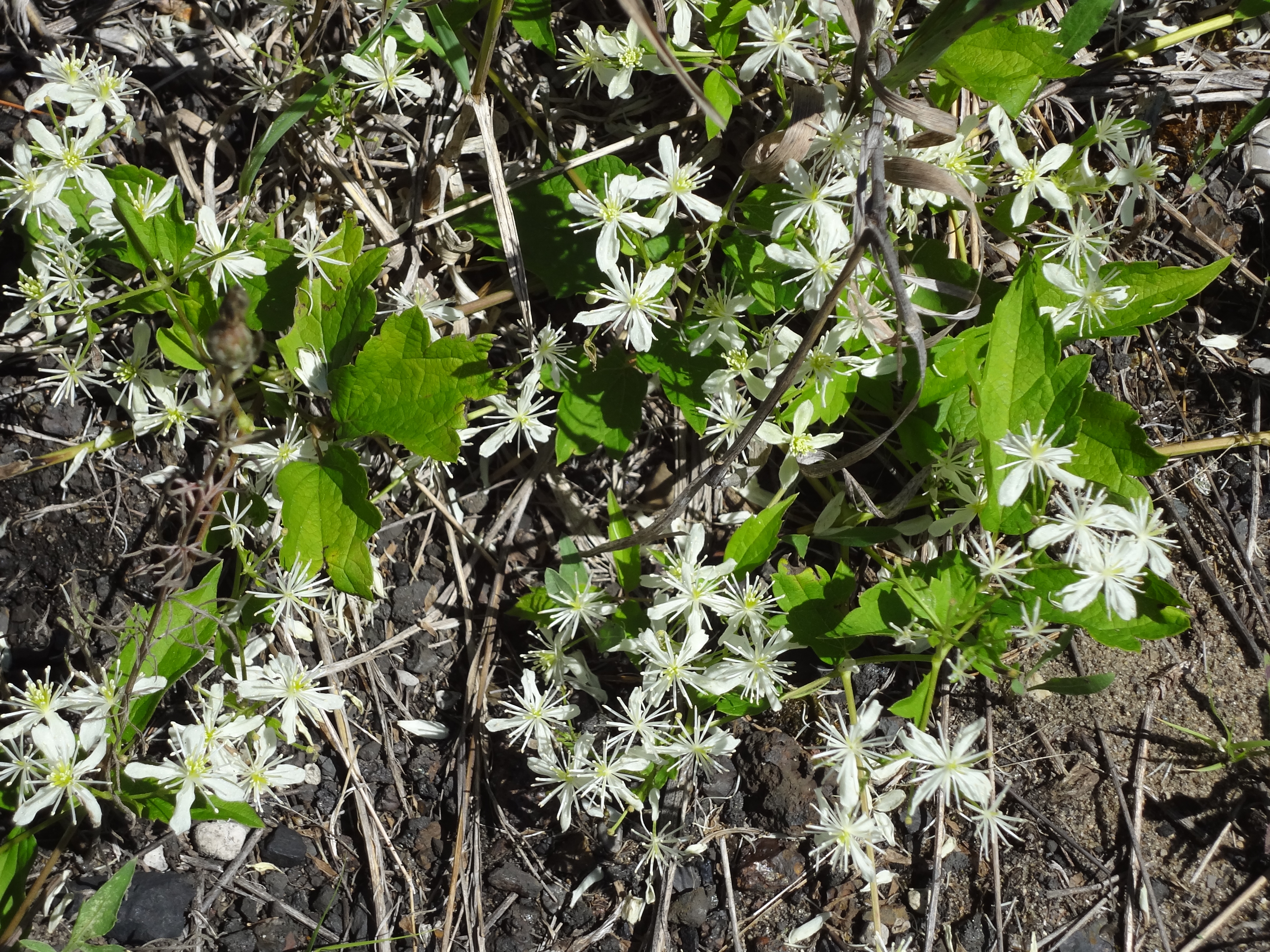 |
Jack-in-the-Pulpit
I photographed these elegant spring flowers in my own backyard (with digital camera). I am not saying how they got there or where they came from. Just call me the stealth gardener.
|
Virgin's Bower
These were abundant growing through other low greenery along the railroad path at Skegemog Swamp. Lack of clarity due to the limitations of the little Sony digital camera.
|
Nature that Moves Around
 |
 |
Don't tread on me!
Actually, I almost did step on that Eastern Massasauga Rattlesnake (Michigan's only venomous snake). It was basking in the sun on the Skegemog railroad
right-of-way nor far from the sign which appears below.
Skinny dippin'
This snake skin is looking mighty lengthy as it sits in the Ocqueoc River at Ocqueoc falls - place where we always go swimming! I am so glad
that we encountered the skin rather than it's former contents in the waters there.
| |
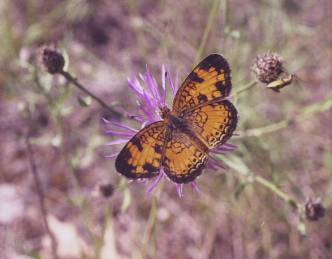 |
 |
Spotted on the knapweed
This pretty little butterfly was kind enough to sit still on the spotted knapweed long enough for me to get real close with the camera.
This way to the Swamp
As that path nears the swamp it turns into a boardwalk that is barely above water in parts. At the swamp end of the boardwalk there is platform
with a stairway to an observation deck about 15 feet high overlooking the swamp. Standing on that deck, I get the feeling that I am miles from
anywhere (probably because it's the truth.) I've been to Skegemog quite a few times, and it's almost always deserted there. One time, as I was
photographing some flowers from the boardwalk I heard a funny noise. After a minute, it dawned on me that I was hearing the rattle of a rattlesnake.
I high-tailed it out of there - leaping down the floating boardwalk trying to take as few steps on it as possible. That was just a little
too much nature for me.
| |
 |
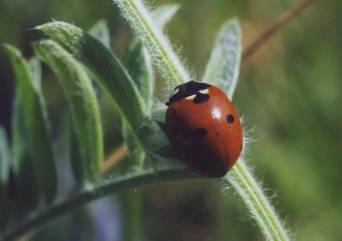 |
A Big Question Mark
|
The New VW
|
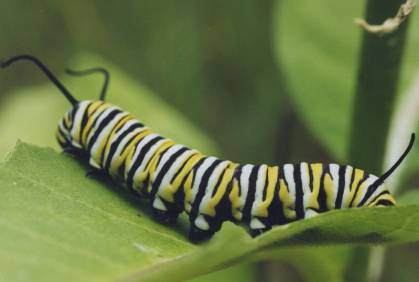 |
 |
Before . . .
This Monarch-to-be is all I need to identify the plant as common milkweed.
. . . and after
What a metamorphosis!
| |
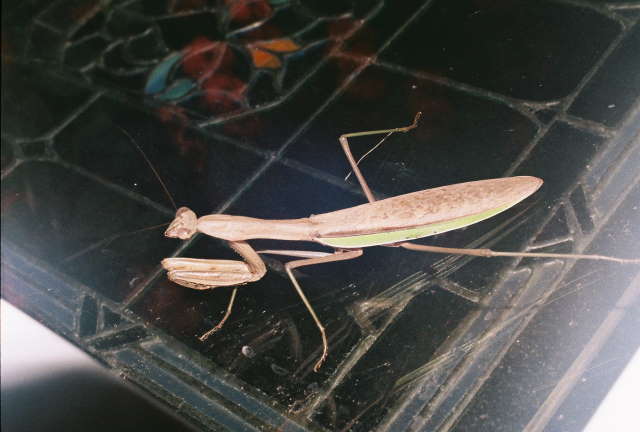 |
 |
Praying Mantis
Hardly a summer goes by without some praying mantis camping out on my front screen door or one of the windows.
Deer
Spotted trailside while riding from Crooked Lake to Midland on the Pere Marquette Rail Trail.
| |
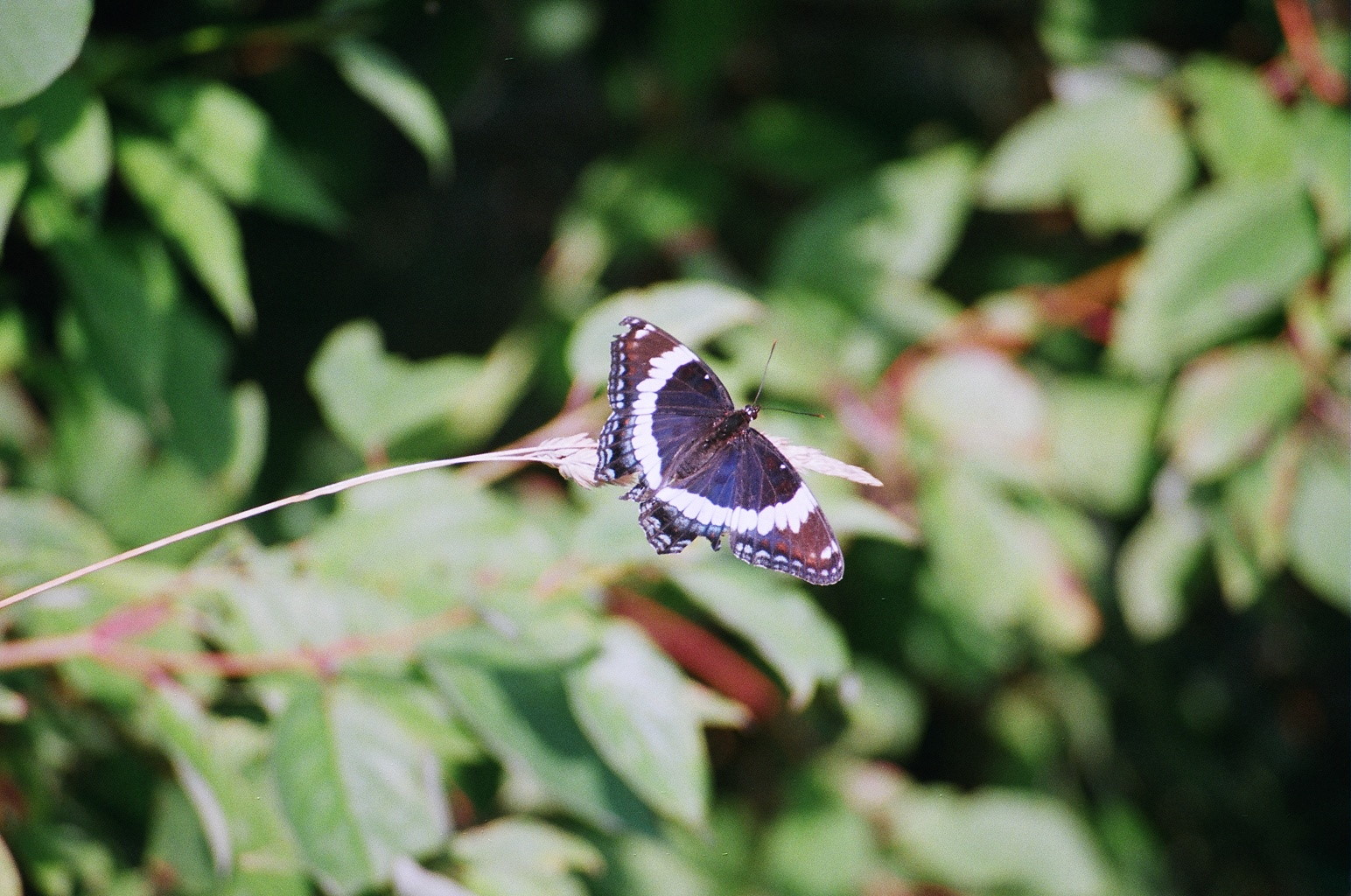 |
 |
White Admiral Butterfly
On the Petosky path, I kept getting closer and clicking until I finally scared that beautiful creature away. Identified by Kathy, of course.
| |
Natural Areas
 |
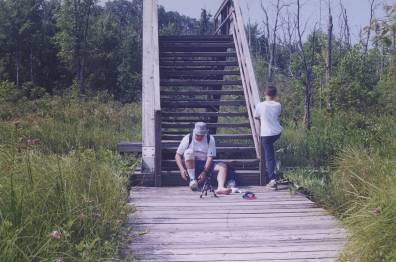 |
Skegemog Swamp Natural Area
This sign marks the extreme climate change that takes place when one leaves the old railroad bed - full sun, high and dry - and turns into the dark, damp woods
leading to the swamp. Skegemog is my all-time favorite natural area - no other site comes close.
Seven Ponds Natural Area
I thought that maybe I could wade over to some wildflowers for a picture, but the water was too deep. I love going to Seven Ponds - it's always fun. There are trails through the woods, boardwalks, and even a huge prairie! The Nature Center and its store are nice, too.
| |
 |
 |
Birding from the Bridge
This is the newly rebuilt bridge whose predecessor is pictured just above. The new bridge is beautiful, and so is the refurbished Nature Center at Seven Ponds.
Where to eat in Metamora
If you come to Seven Ponds from Lapeer Road, as you drive across Dryden Road, you will encounter this wonderful tavern at the corner of Metamora (the only traffic light.) Eat there - you will be glad that you did. White Horse Inn
Sad Footnote: After 162 years of operation, the Inn closed on November 14, 2012 due to structural problems that were too costly to repair.
| |
 |
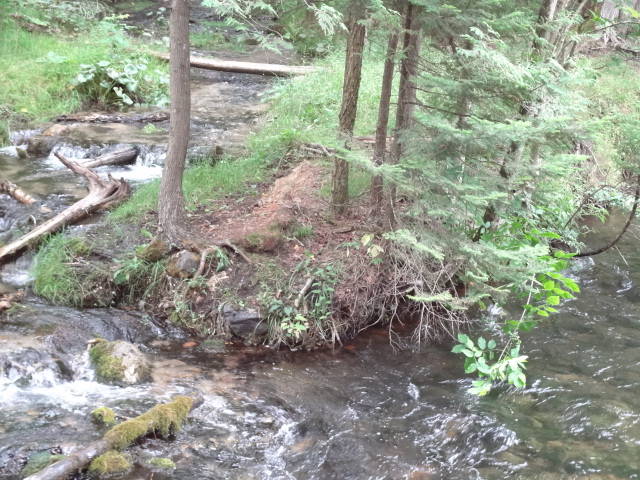 |
Grass River Natural Area
Not letting water stop me, I waded right in to get a closer look at the unidentified blue wildflower. It turned out to be forget-me-nots, and I should have known it by the habitat. The water was pretty cold.
Seven Bridges Natural Area
This deligthful place is truly off the beaten path. You would drive by the dusty inconspicuous parking lot never dreaming that just inside the woods water is splashing in every direction. Bring a lunch, pick a bench, and watch the many little streams merge and split, water coming seemingly from all directions. Seven Bridges is not to be missed!
| |

|
Here is a list of my favorite places to view nature.
Each one has a link to some sort of information about the natural area.
|
Alphabetical Index of the Pictures
- Arrowhead • 8
- Autumn Wild Onion • 5
- Beach Heath • 57
- Beach Pea • 34
- Bearberry • 10
- Birdsfoot Trefoil • 30
- Bittersweet Nighshade • 24
- Bladder Campion • 21
- Bloodroot • 70
- Blue-Eyed Grass • 27
- Blue Vervain • 29
- Blueweed • 51
- Boneset • 59
- Bouncing Bet • 15
- British Soldiers • 49
- Bull Thistle • 26
- Bunchberry • 31
- Butter and Eggs • 10
- Canada Anemone • 45
- Canada Mayflower • 38
- Canada Thistle • 63
- Cardinal Flower • 2
- Catnip • 18
- Chicory • 31
- Chinese Lantern • 68
- Closed Gentian • 7
- Columbine • 28
- Common Burdock • 19
- Common Cattail • 63
- Common Milkweed • 41
- Common Mullein • 41
- Common Nightshade • 56
- Common Plantain • 54
- Common St. John's Wort • 20
- Common Skullcap • 38
- Common Winter Cress • 58
- Compass Plant • 24
- Crabgrass • 62
- Crown Vetch • 17
- Culver's Root • 40
- Curled Dock • 34
- Cutleaf Toothwort • 49
- Daisy Fleabane • 51
- Deptford Pink • 43
- Dune Lily • 35
- Dutchman's Breeches • 58
- Dwarf Lake Iris • 36
- English Plantain • 23
- Evening Lychnis • 26
- Evening Primrose • 45
- Everlasting Pea • 32
- False Solomon's Seal • 67
- Field BIndweed • 32
- Fireweed • 23
- Fragrant Water Lily • 44
- Fringed Gentian • 4
- Fringed Polygala • 1
- Fringed Purple Orchid • 30
- Goatsbeard • 35
- Grass Pink • 5
- Grass-of-Parnassus • 14
- Great Lobelia • 25
- Hairy Vetch • 44
- Harebell • 62
- Hedge Bindweed • 47
- Hoary Allysum • 53
- Honesty • 60
- Horsemint • 46
- Indian Paintbrush • 8
- Indian Pipe • 2
- Indian Tobacco • 40
- Jack-in-the-Pulpit • 71
- Lady's Thumb • 42
- Leadplant • 17
- Moth Mullein, yellow & white • 6
- Mouse-ear Chickweed • 57
- Musk Mallow • 29
- Musk Mallow - Pink • 69
- Nodding Ladies' Tresses • 13
- Obediant Plant • 48
- Orange Hawkweed • 39
- Ox-eye Daisy • 60
- Pearly Everlasting • 47
- Pickerelweed • 22
- Pine Hyacinth • 64
- Pink Mullein • 13
- Pipsissewa • 46
- Pitcher Plant • 25
- Prairie Blazing Star • 65
- Prairie Coneflower • 56
- Purple Gerardia • 20
- Purple Loosestrife • 27
- Purslane • 50
- Queen Anne's Lace • 52
- Rattlesnake Master • 65
- Red Clover • 50
- Round-leaf Sundew • 9
- Saint Peterswort • 52
- Self-Heal • 43
- Shinleaf • 3
- Showy Lady's Slipper • 4
- Silverweed • 33
- Skunk Cabbage • 55
- Smooth Rose • 7
- Sneezeweed • 64
- Sow Thistle • 54
- Spotted Jewelweed • 21
- Spotted Joe Pye Weed • 66
- Spotted Knapweed • 61
- Spreading Dogbane • 67
- Staghorn Sumac • 61
- Starflower • 39
- Starry False Solomon's Seal • 33
- Storksbill • 59
- Striped Coralroot • 16
- Sulphur Cinquefoil • 37
- Swamp Candles • 14
- Swamp Dewberry • 16
- Swamp Milkweed • 53
- Tall Meadow Rue • 69
- Teaberry • 12
- Teasel • 15
- Thimbleberry • 37
- Trillium • 70
- Trout Lily • 12
- Tufted Loosestrife • 48
- Turtlehead • 1
- Twinflower • 36
- Viper's Bugloss • 51
- Virgin's Bower • 71
- Water Hemlock • 3
- White Wood Aster • 68
- Wild Basil • 22
- Wild Bergamot • 18
- Wild Strawberry • 42
- Winter Cress • 58
- Woodland Sunflower • 66
- Wood Lily Sunflower • 19
- Yellow Lady's Slipper • 28
- Yellow Pond Lily • 12
- Yellow Sweet Clover • 55
|
|

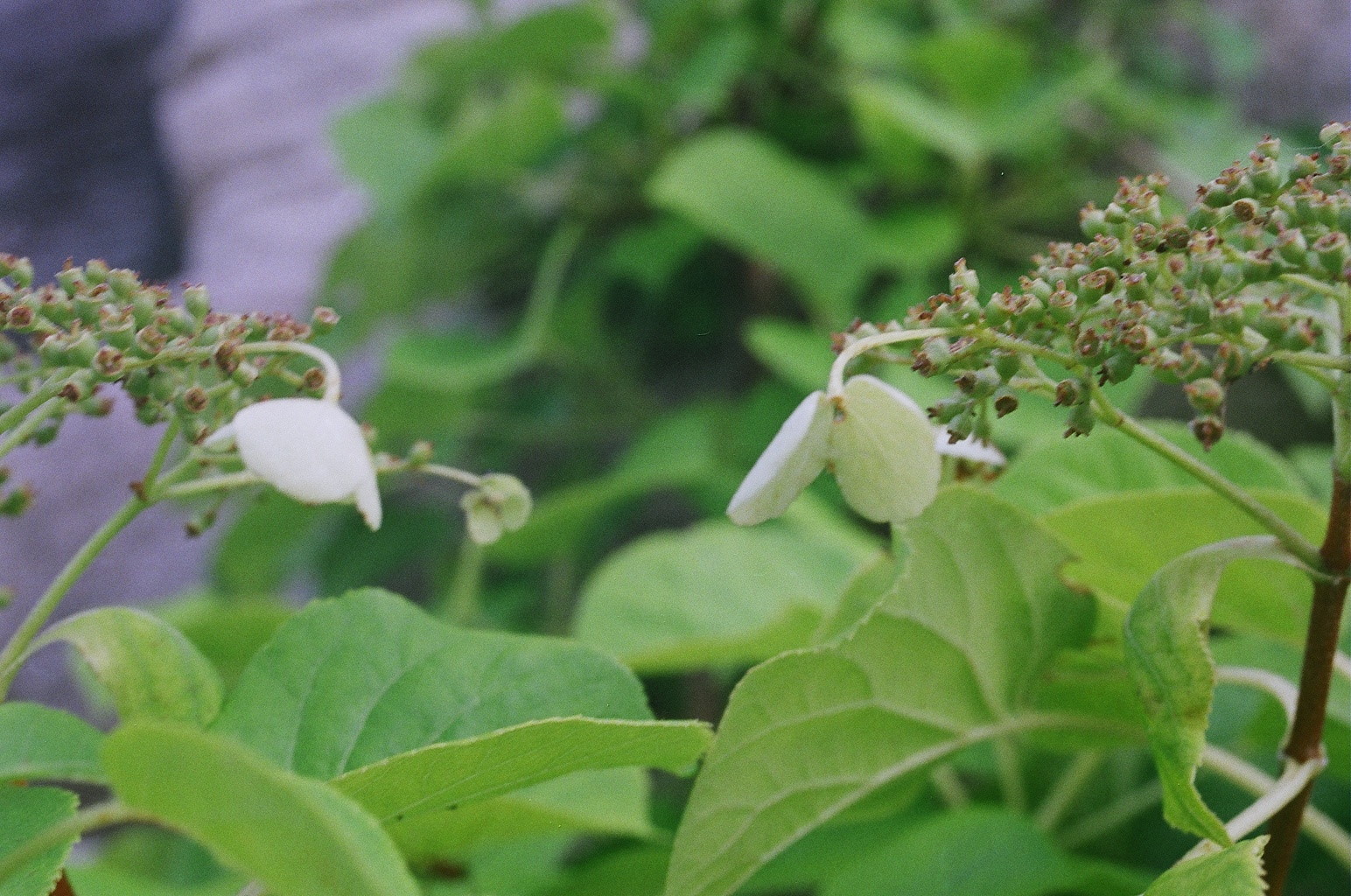
|



 Spring 2014 - Yes, after the winter from Hell, it is finally warm enough to call this a spring. Though I no longer get up north at this time of year, I have been visiting the woods on Camille's farm northeast of Ann Arbor, and I participated in a wildflower tour on Belle Isle, too. Unfortunately - after years of faithful service - my Pentax ZX-30 (film) camera recently died. I am hoping this is a temporary condition, but meanwhile, I have missed a couple of photo-ops on wildflowers that are not in my collection below. I did snap them using my little Sony digital, but the results are nowhere as good. I completely missed out on photographing spring beauty which was blooming in abundance at Camille's, and Jack-in-the-pulpit on Belle Isle. I did get a nice picture of bloodroot for the first time. Here is a picture of it's cool leaves which I took with my digital camera. This is from my own back yard where I transplanted some of the spring bloomers from Camille's farm and from the Belle Isle woods, too.
Spring 2014 - Yes, after the winter from Hell, it is finally warm enough to call this a spring. Though I no longer get up north at this time of year, I have been visiting the woods on Camille's farm northeast of Ann Arbor, and I participated in a wildflower tour on Belle Isle, too. Unfortunately - after years of faithful service - my Pentax ZX-30 (film) camera recently died. I am hoping this is a temporary condition, but meanwhile, I have missed a couple of photo-ops on wildflowers that are not in my collection below. I did snap them using my little Sony digital, but the results are nowhere as good. I completely missed out on photographing spring beauty which was blooming in abundance at Camille's, and Jack-in-the-pulpit on Belle Isle. I did get a nice picture of bloodroot for the first time. Here is a picture of it's cool leaves which I took with my digital camera. This is from my own back yard where I transplanted some of the spring bloomers from Camille's farm and from the Belle Isle woods, too.
 The week of August 13th: Four days up north at Natural Areas and riding down bike trails will translate to a bunch of new pictures of wildflowers below. I identified several wildflowers for the first time, and Kathy helped a lot. We saw even more that we couldn't identify - yet. When I get the my film developed, I will have a session with the wildflower books. Notably, we went to Skegemog Swamp and Grass River Natural Area, with its brand new nature center. The bike trails were a good source of flowers, too. The highlight of the trip from a bird standpoint was when we were riding the trail between Petosky and Charlevoix, and a huge barred owl swooped within a couple feet of us and then perched and sat in the tree above us. I managed to get a few pictures with my telephoto lens.
The week of August 13th: Four days up north at Natural Areas and riding down bike trails will translate to a bunch of new pictures of wildflowers below. I identified several wildflowers for the first time, and Kathy helped a lot. We saw even more that we couldn't identify - yet. When I get the my film developed, I will have a session with the wildflower books. Notably, we went to Skegemog Swamp and Grass River Natural Area, with its brand new nature center. The bike trails were a good source of flowers, too. The highlight of the trip from a bird standpoint was when we were riding the trail between Petosky and Charlevoix, and a huge barred owl swooped within a couple feet of us and then perched and sat in the tree above us. I managed to get a few pictures with my telephoto lens.
 August 5th through 7th: Riding on the Pere Marquette Rail Trail - about fifty miles each way - provided a wealth of wildflower viewing. It was Kathy who spotted the cardinal flower - brilliant red, as always. When stopped to look at it, we noticed two other flower types. I was able to identify both, and both were new to me: Pine hyacinth, and Showy tick trefoil. Why didn't I bring my SLR camera??? Of course, Kathy was super at spotting and identifying birds - she is amazing in that way. From a boardwalk/bridge near Clare, we saw killdeers and a whole bunch of green herons. We heard lots of catbirds. But the best was when we pulled off the trail to look at a little lake. The driveway to the lake had a "No Tresspassing" sign, but I convinced Kathy that there were no buildings around and it wouldn't hurt to ride to the edge of the lake. Before we even reached the water, Kathy went nuts. With her bare eyes she picked out a bald eagle in a dead tree way on the other side of the lake! Through her binoculars I could see it perfectly. That was so awesome. Other animals we saw right on the trail, included deer, chipmunks, a green and yellow snake, rabbits, frogs, a family of wild turkeys (in the picture), seventeen million grasshoppers, and even a dead mouse. Bring on the next trail!
August 5th through 7th: Riding on the Pere Marquette Rail Trail - about fifty miles each way - provided a wealth of wildflower viewing. It was Kathy who spotted the cardinal flower - brilliant red, as always. When stopped to look at it, we noticed two other flower types. I was able to identify both, and both were new to me: Pine hyacinth, and Showy tick trefoil. Why didn't I bring my SLR camera??? Of course, Kathy was super at spotting and identifying birds - she is amazing in that way. From a boardwalk/bridge near Clare, we saw killdeers and a whole bunch of green herons. We heard lots of catbirds. But the best was when we pulled off the trail to look at a little lake. The driveway to the lake had a "No Tresspassing" sign, but I convinced Kathy that there were no buildings around and it wouldn't hurt to ride to the edge of the lake. Before we even reached the water, Kathy went nuts. With her bare eyes she picked out a bald eagle in a dead tree way on the other side of the lake! Through her binoculars I could see it perfectly. That was so awesome. Other animals we saw right on the trail, included deer, chipmunks, a green and yellow snake, rabbits, frogs, a family of wild turkeys (in the picture), seventeen million grasshoppers, and even a dead mouse. Bring on the next trail!
 April 6th Thursday afternoon was so warm and sunny. I took my camera and wildflower book to the park where I had seen some tiny purple flowers blooming. I must have been laying on the ground for over half an hour, looking through the pictures in the flower book and carefully reading the plant descriptions. I finally decided that what I was taking pictures of was Storksbill because of the fernlike leaves and the hairy flower stems. In the same area, I discovered another tiny pink flower growing. It was orchid-like in shape, but only about one quarter inch in size. I could not find anything like it in the book - I hate it when that happens. Meanwhile, in my back yard, the viburnum is blooming now and the sweet smell hits me as soon as I walk out the back door. When I planted that bush it was less than two feet high, and now it is taller than my one-story house.
April 6th Thursday afternoon was so warm and sunny. I took my camera and wildflower book to the park where I had seen some tiny purple flowers blooming. I must have been laying on the ground for over half an hour, looking through the pictures in the flower book and carefully reading the plant descriptions. I finally decided that what I was taking pictures of was Storksbill because of the fernlike leaves and the hairy flower stems. In the same area, I discovered another tiny pink flower growing. It was orchid-like in shape, but only about one quarter inch in size. I could not find anything like it in the book - I hate it when that happens. Meanwhile, in my back yard, the viburnum is blooming now and the sweet smell hits me as soon as I walk out the back door. When I planted that bush it was less than two feet high, and now it is taller than my one-story house.
 March 18th, 2012: We're having a heat wave, a tropical heat wave. So many things are blooming early and some of them are in my back yard. Cute little purple flowers are peeking out from the myrtle all over the yard, and for the first time in three years, the pieris is covered with tiny white flowers. I love my little yard.
March 18th, 2012: We're having a heat wave, a tropical heat wave. So many things are blooming early and some of them are in my back yard. Cute little purple flowers are peeking out from the myrtle all over the yard, and for the first time in three years, the pieris is covered with tiny white flowers. I love my little yard.









































































































































































